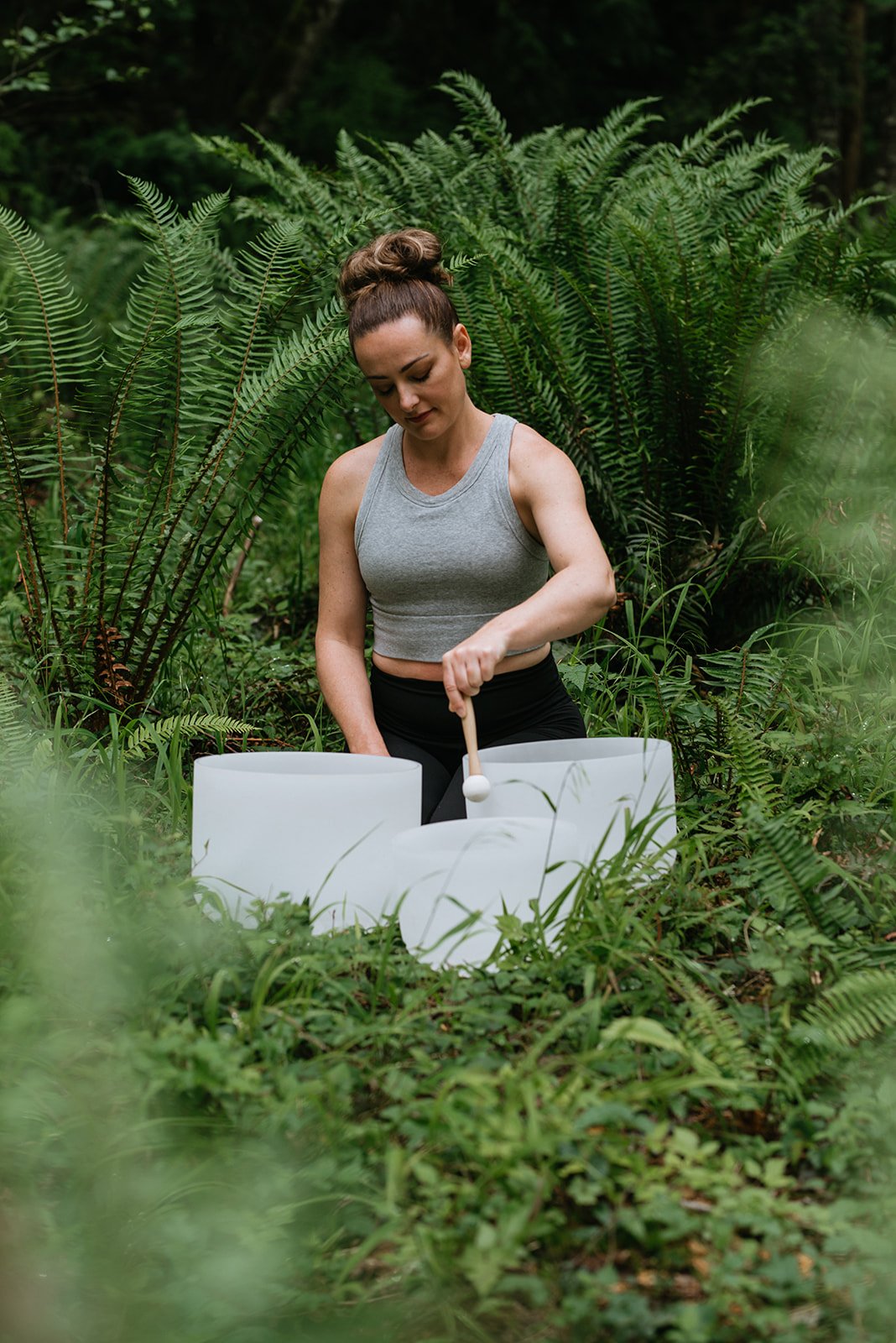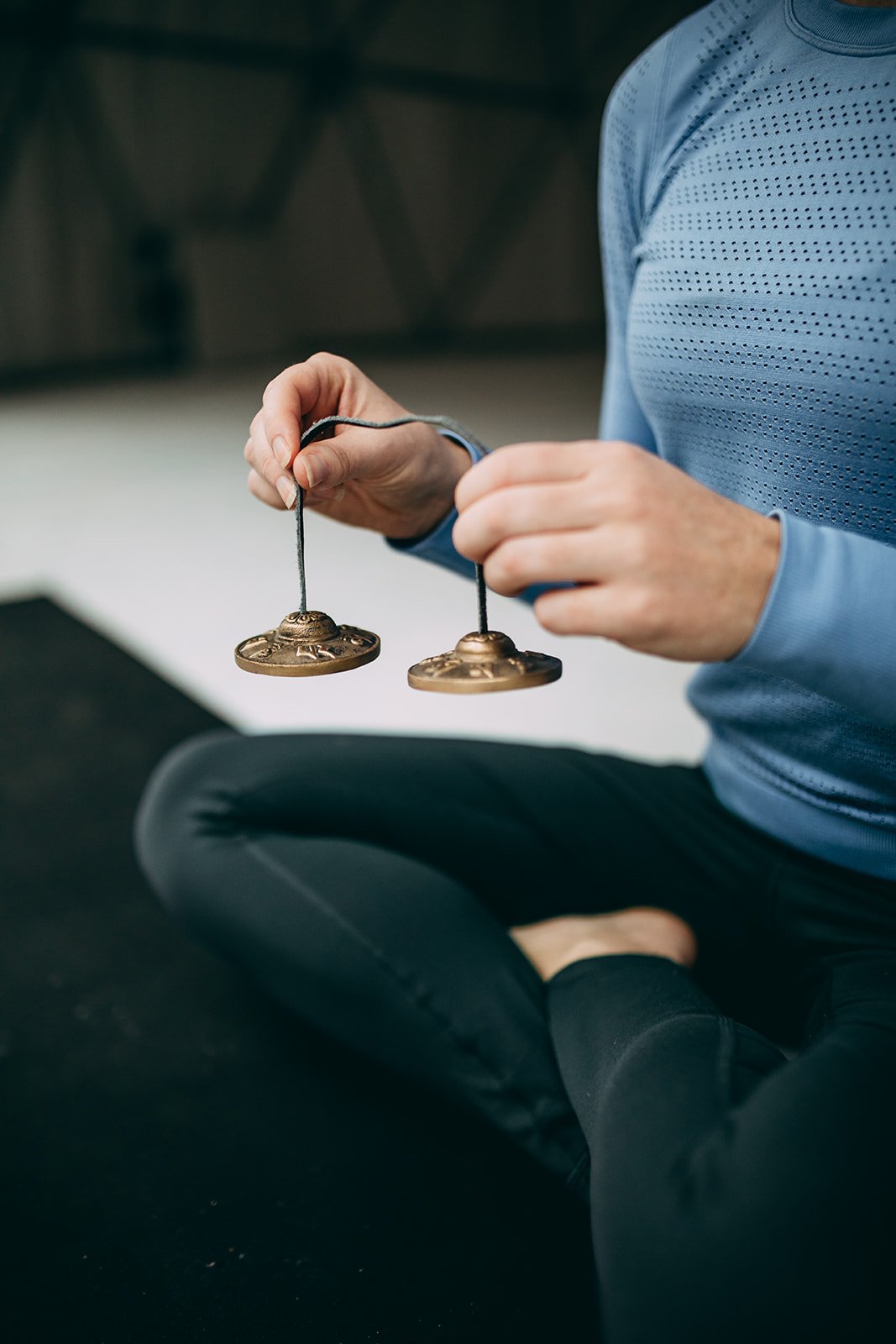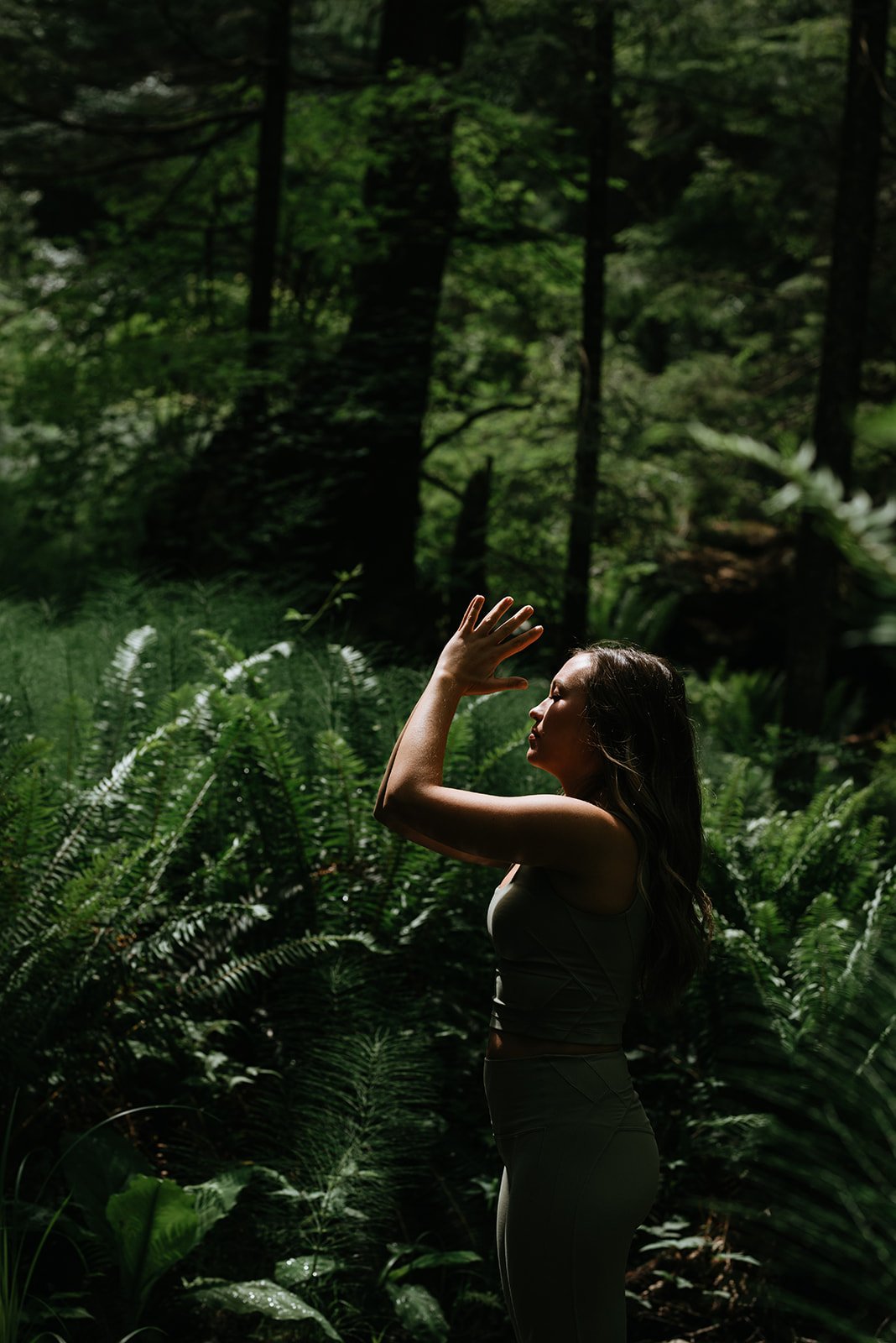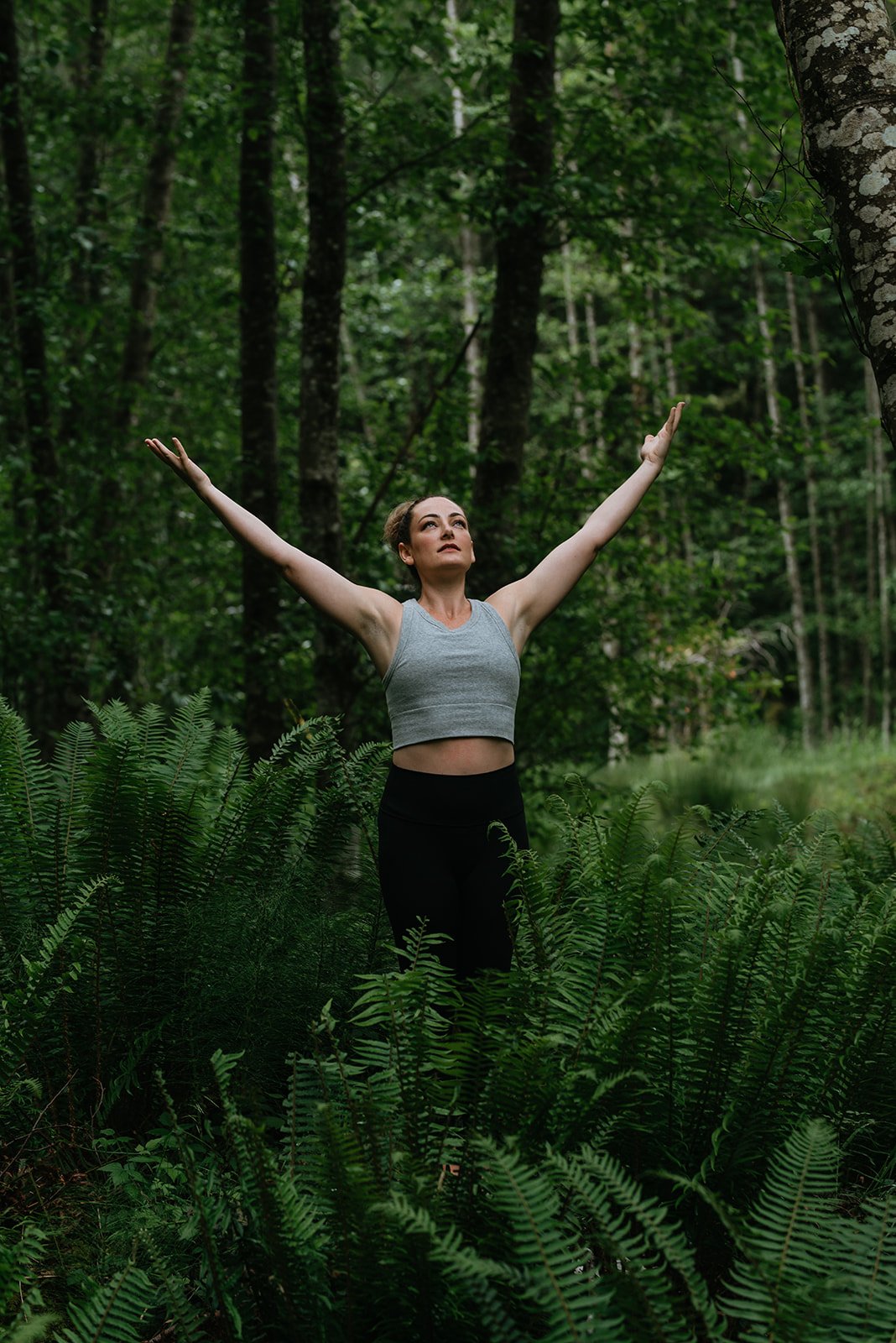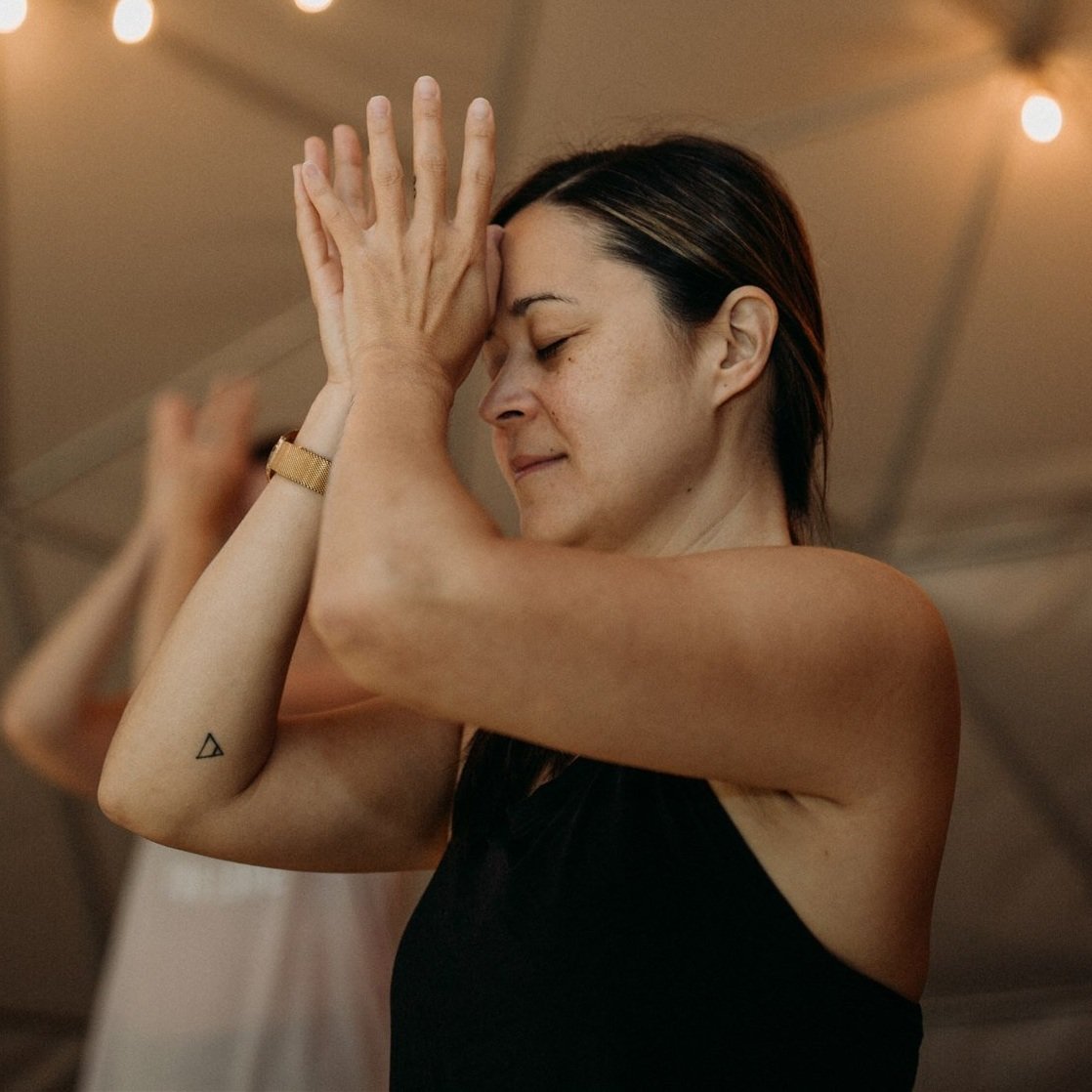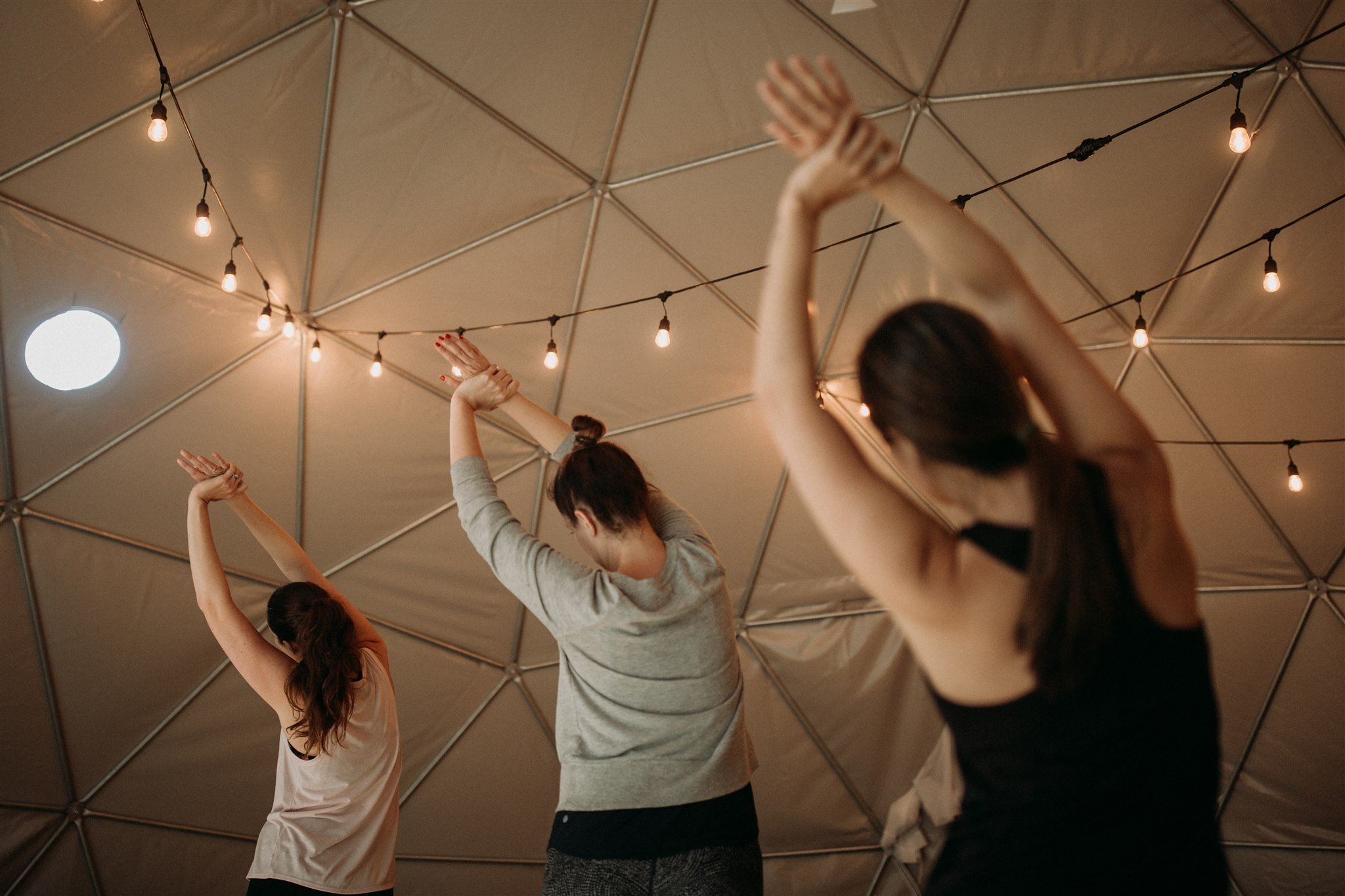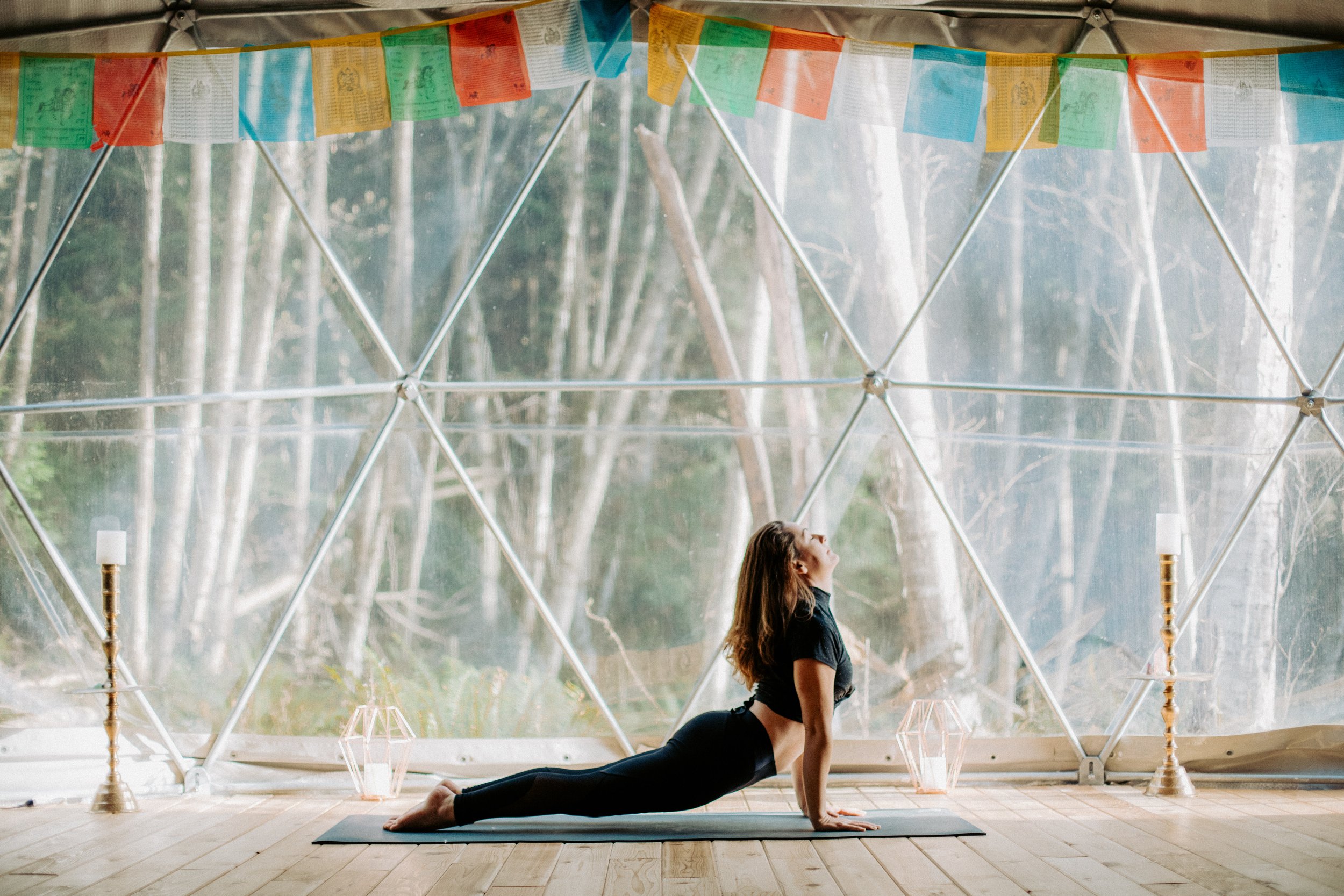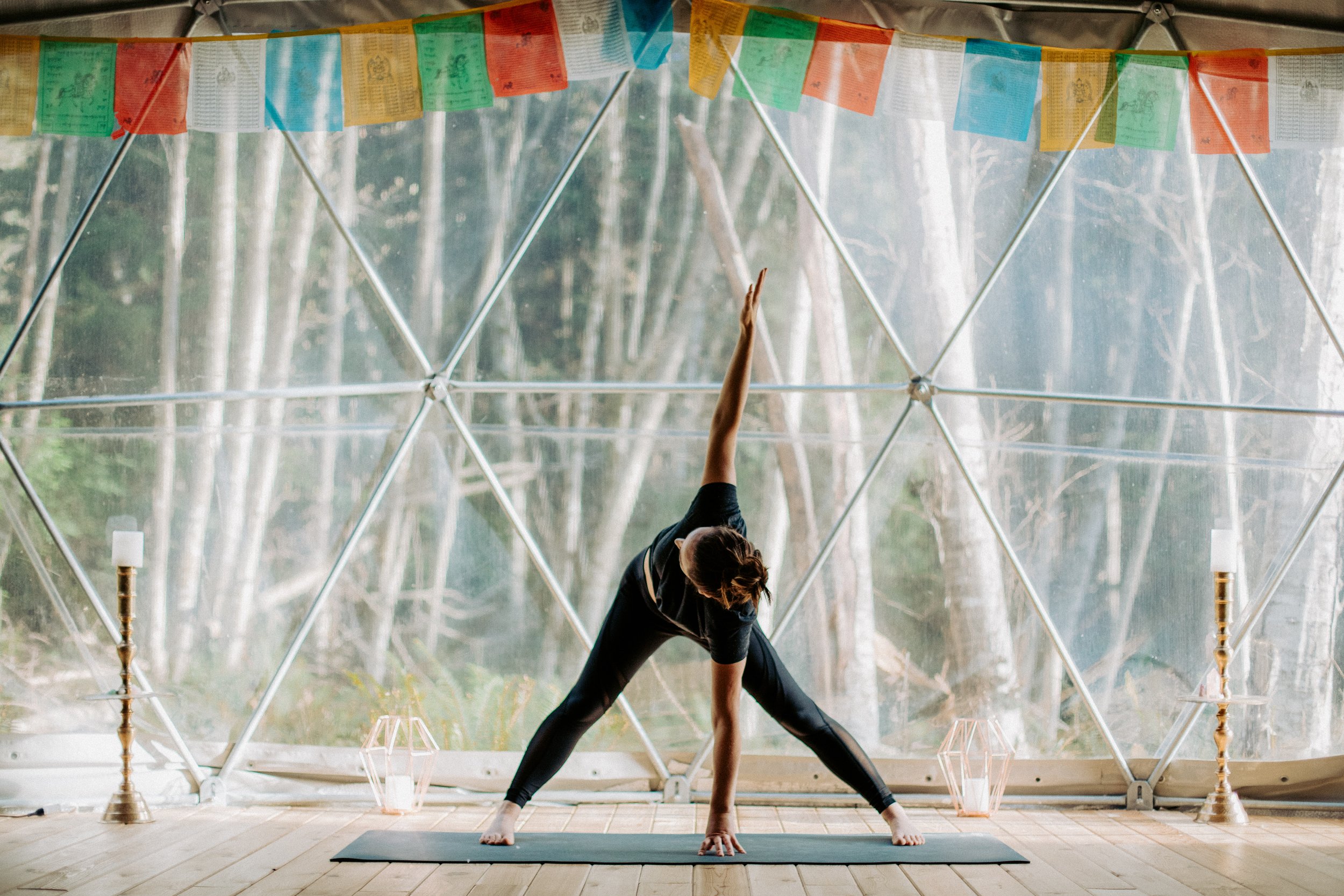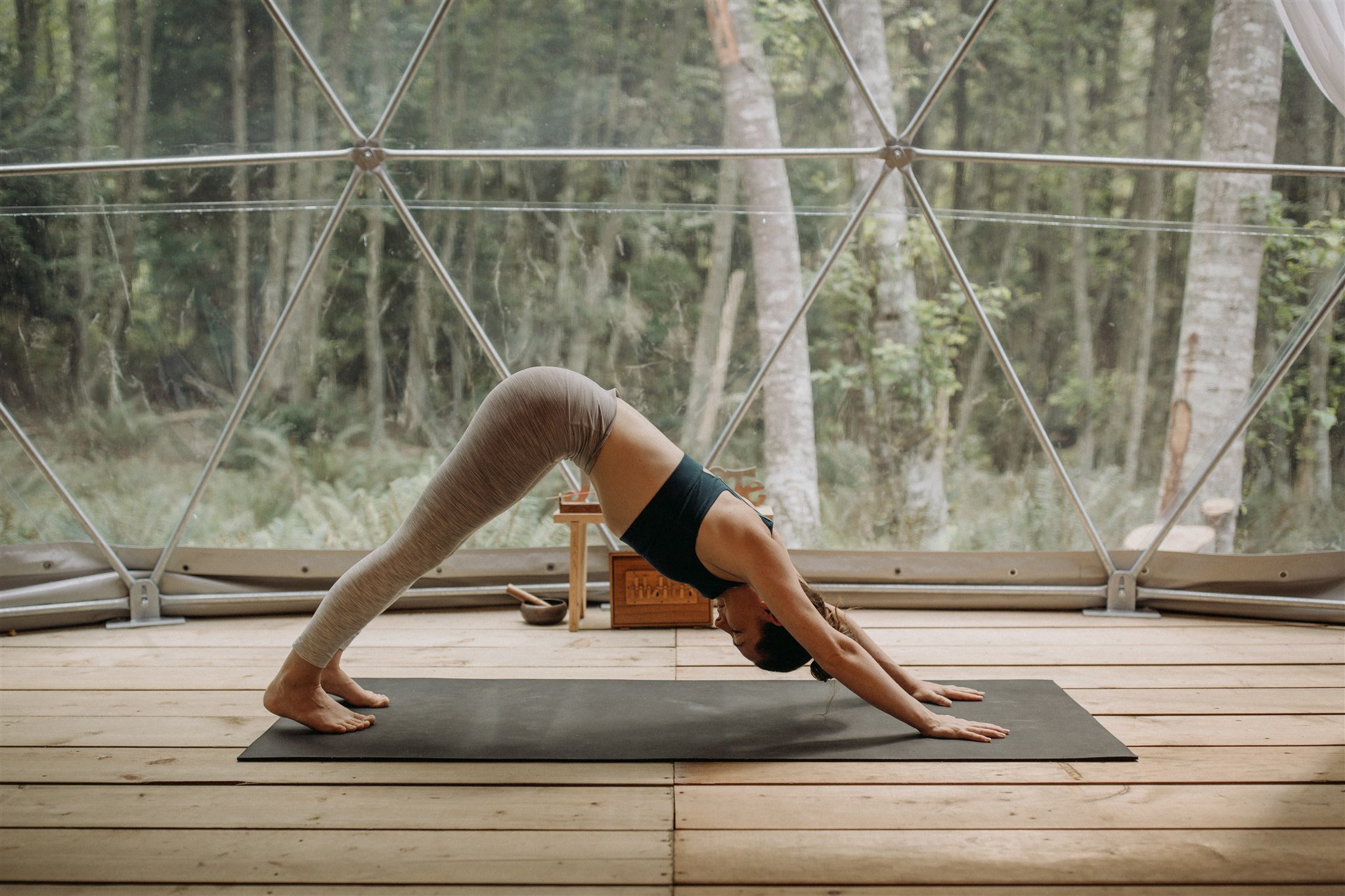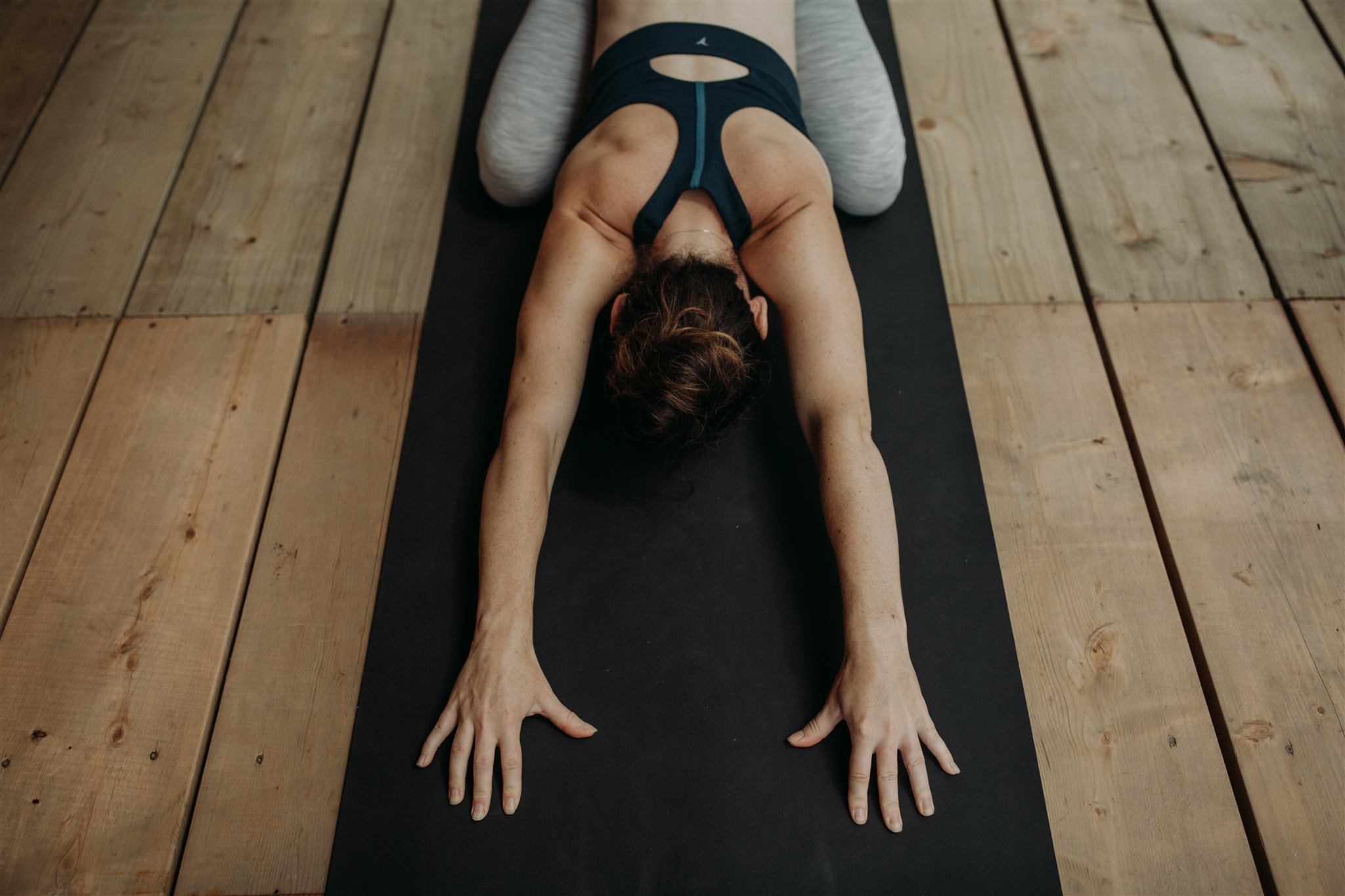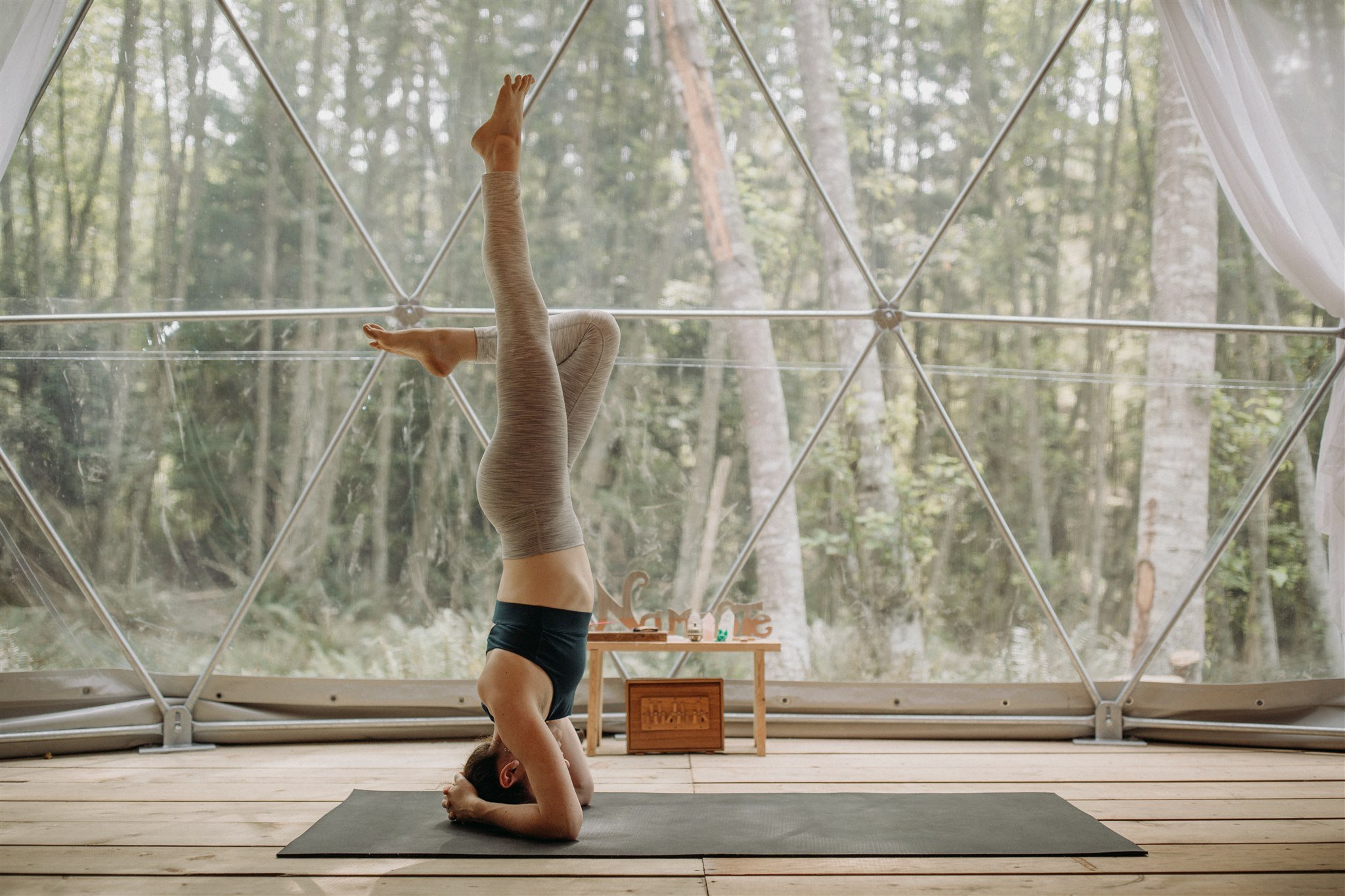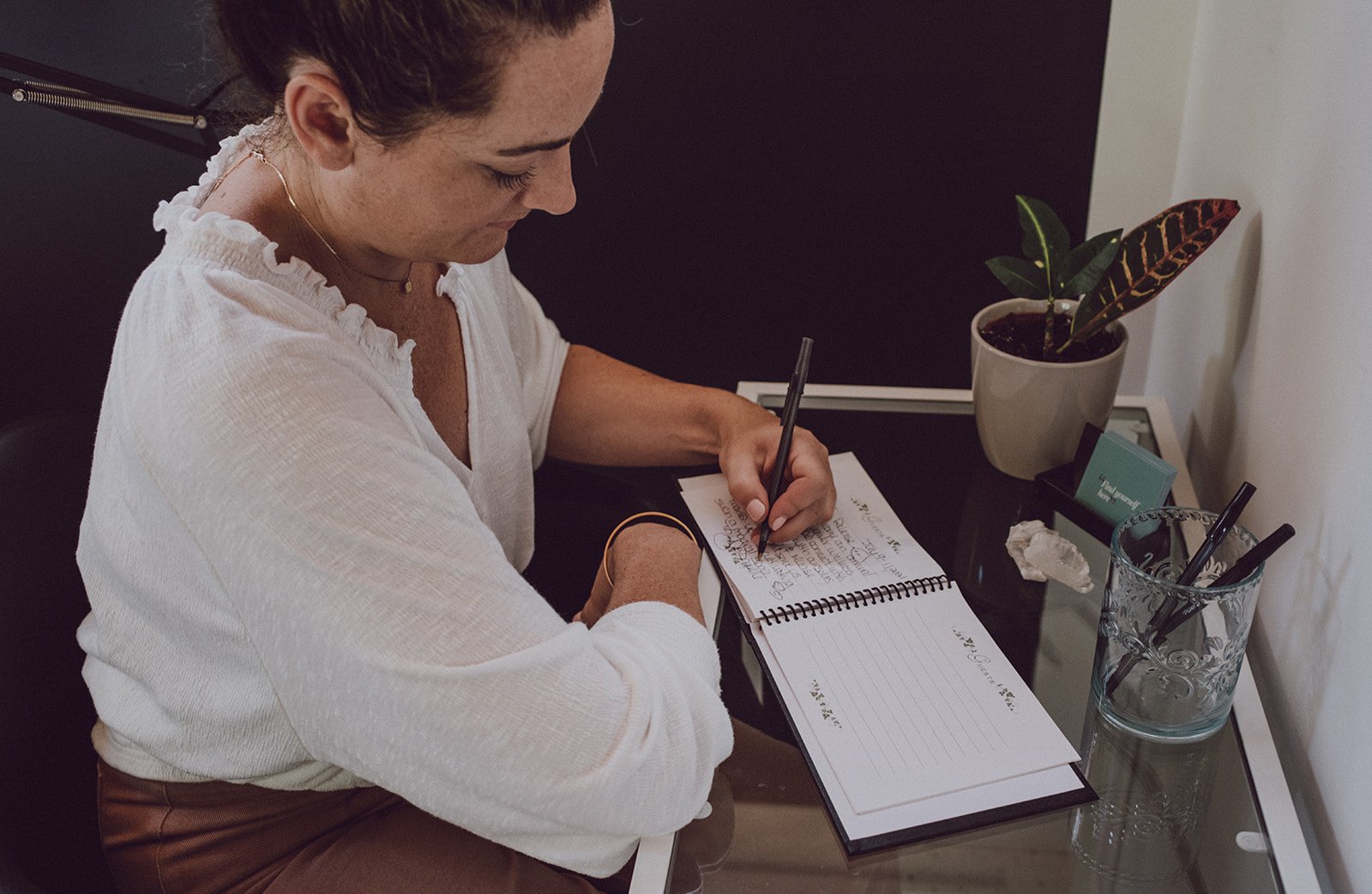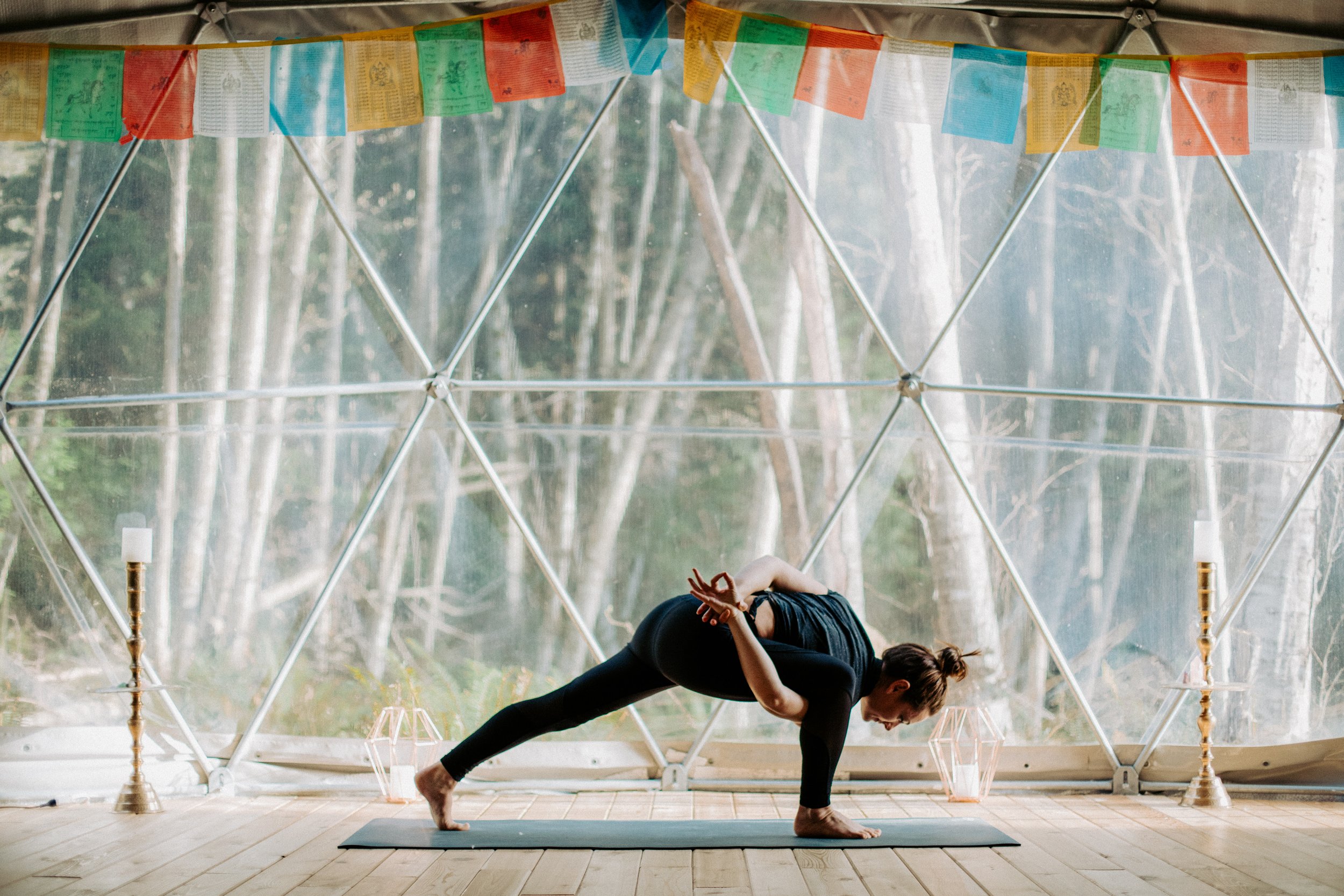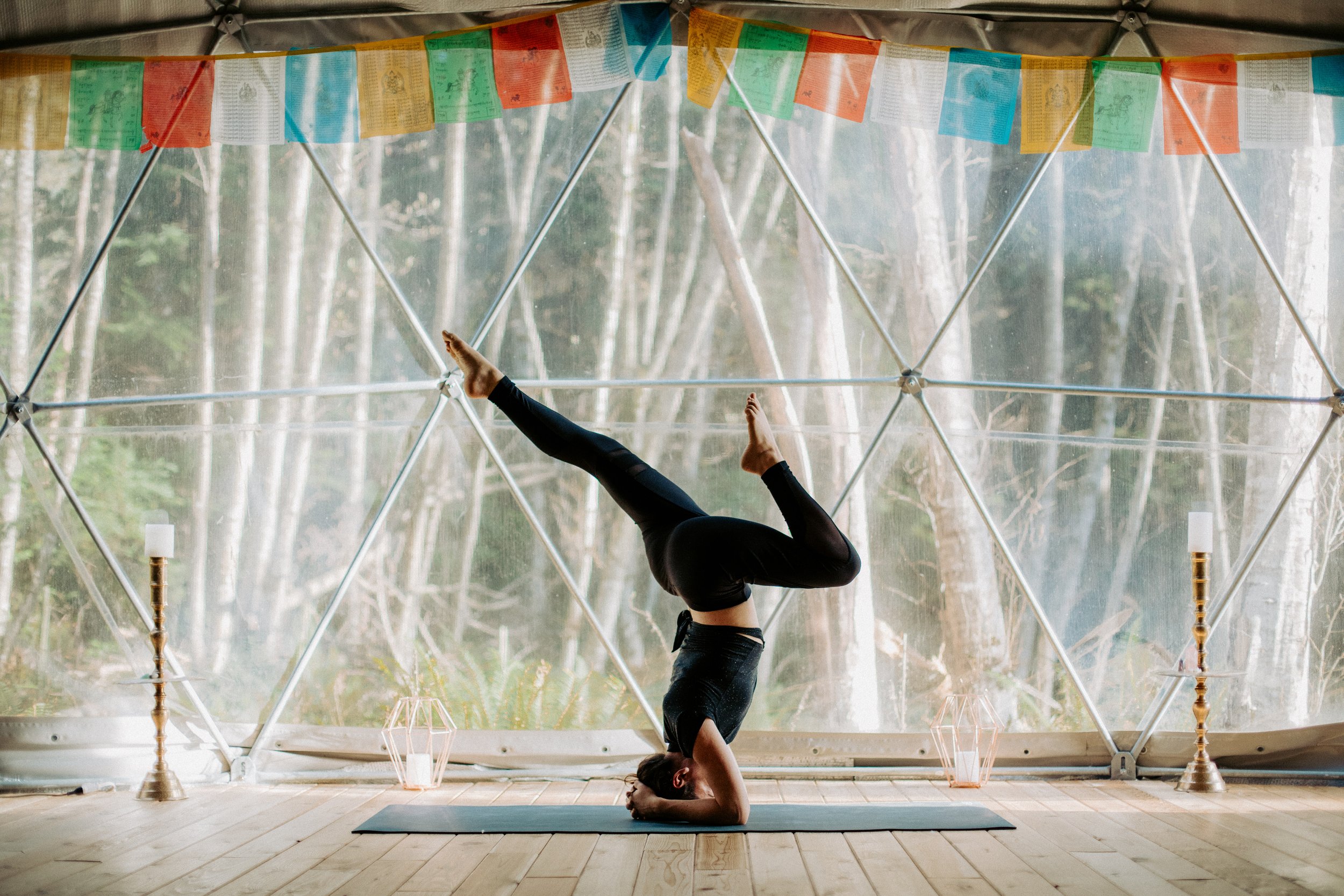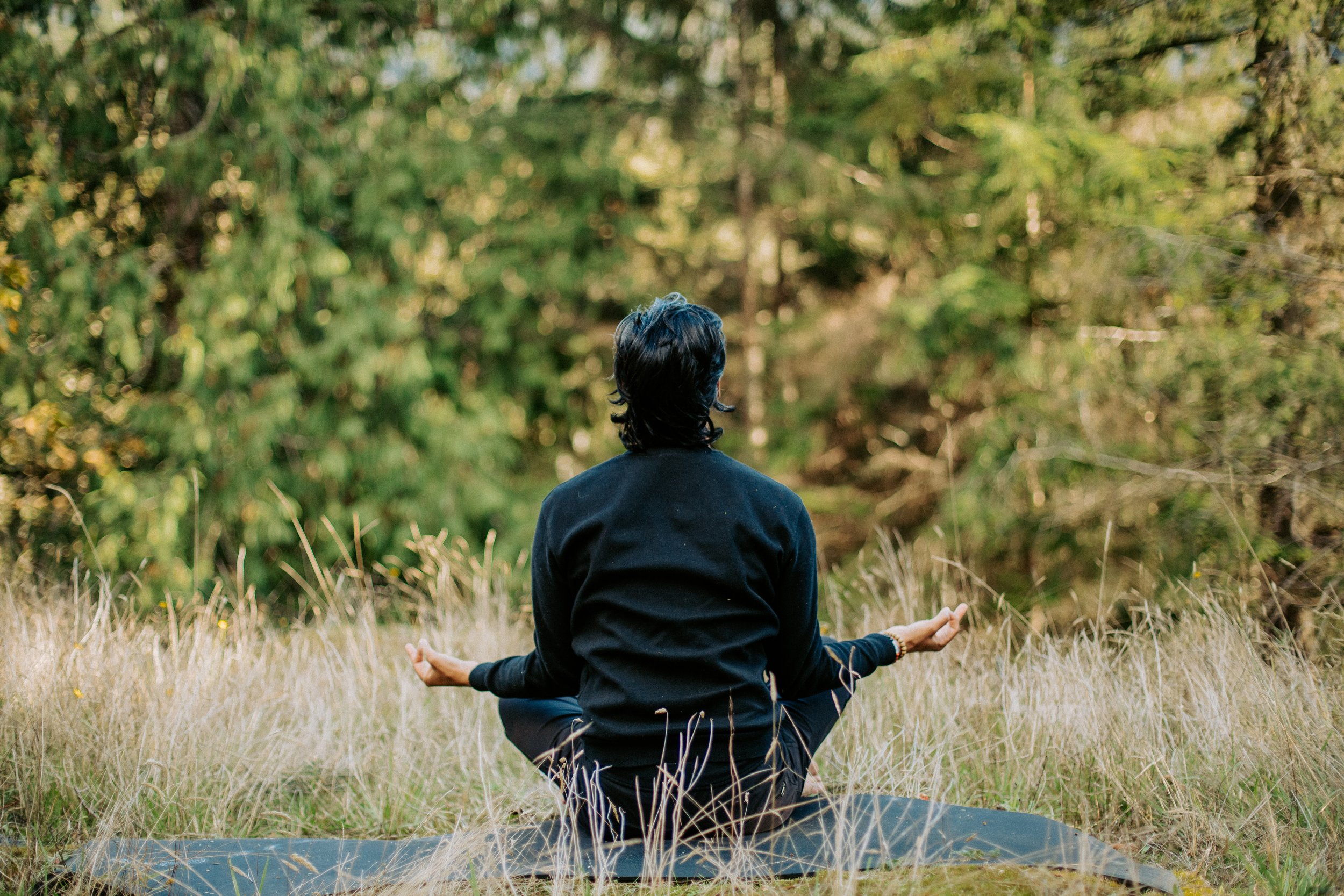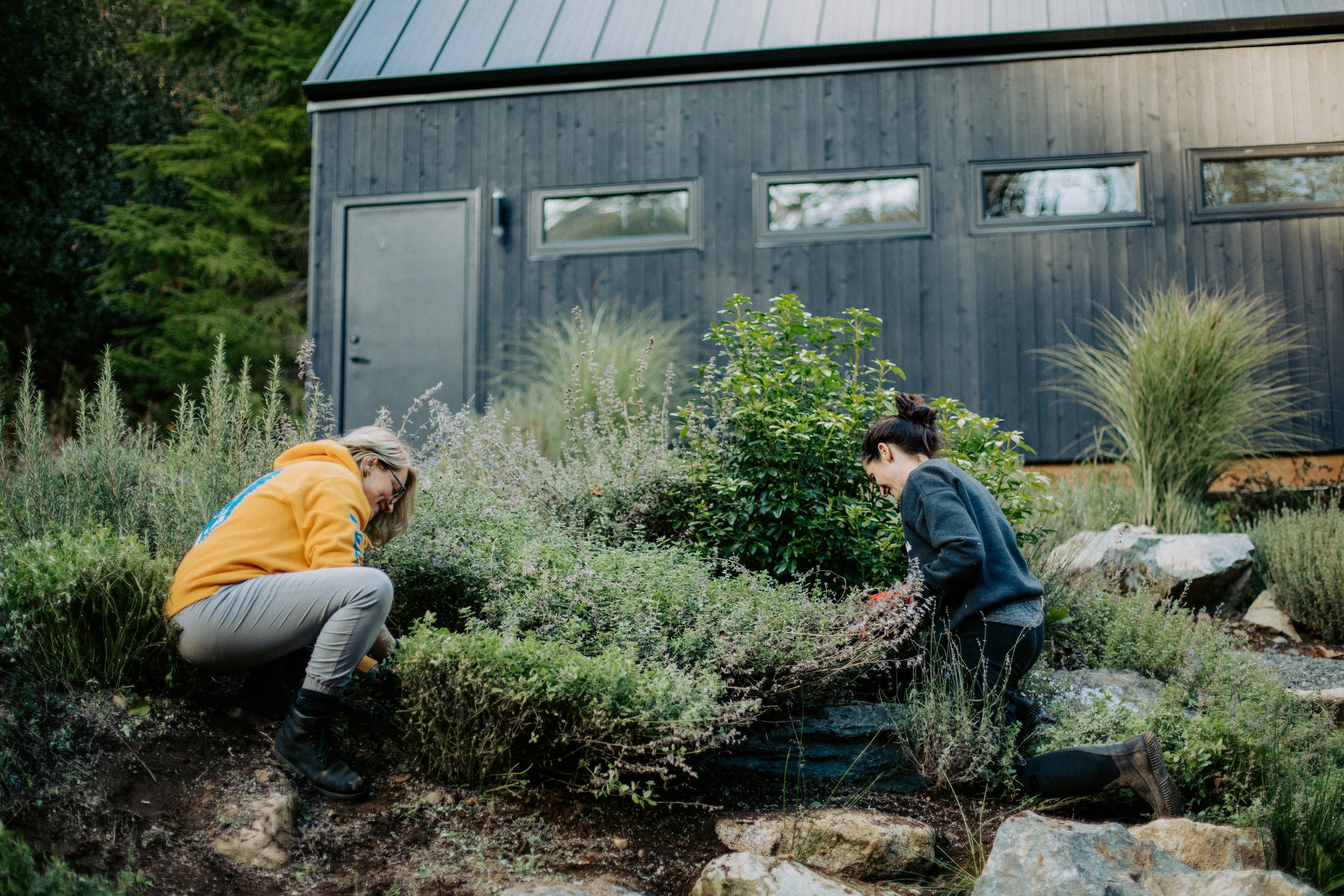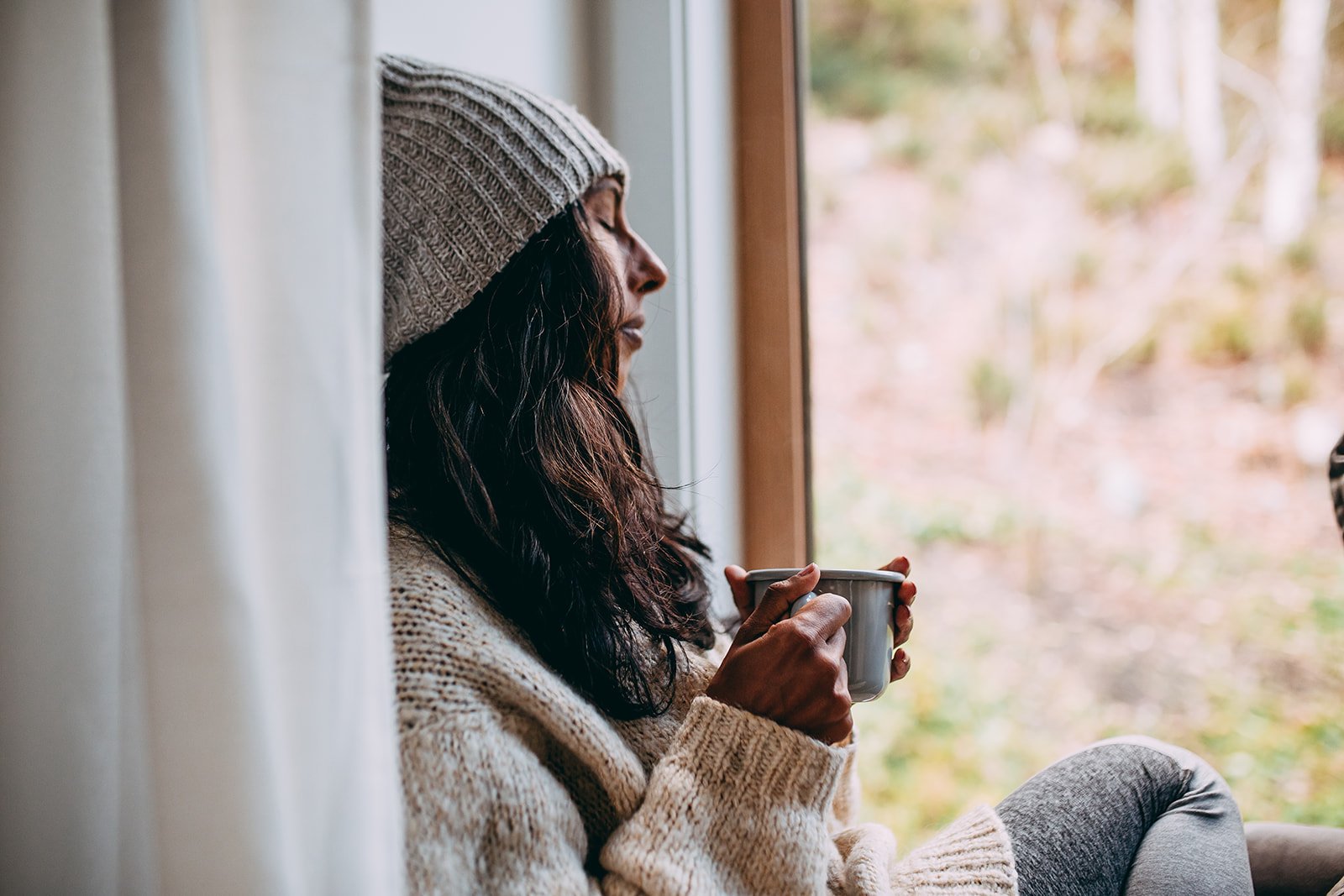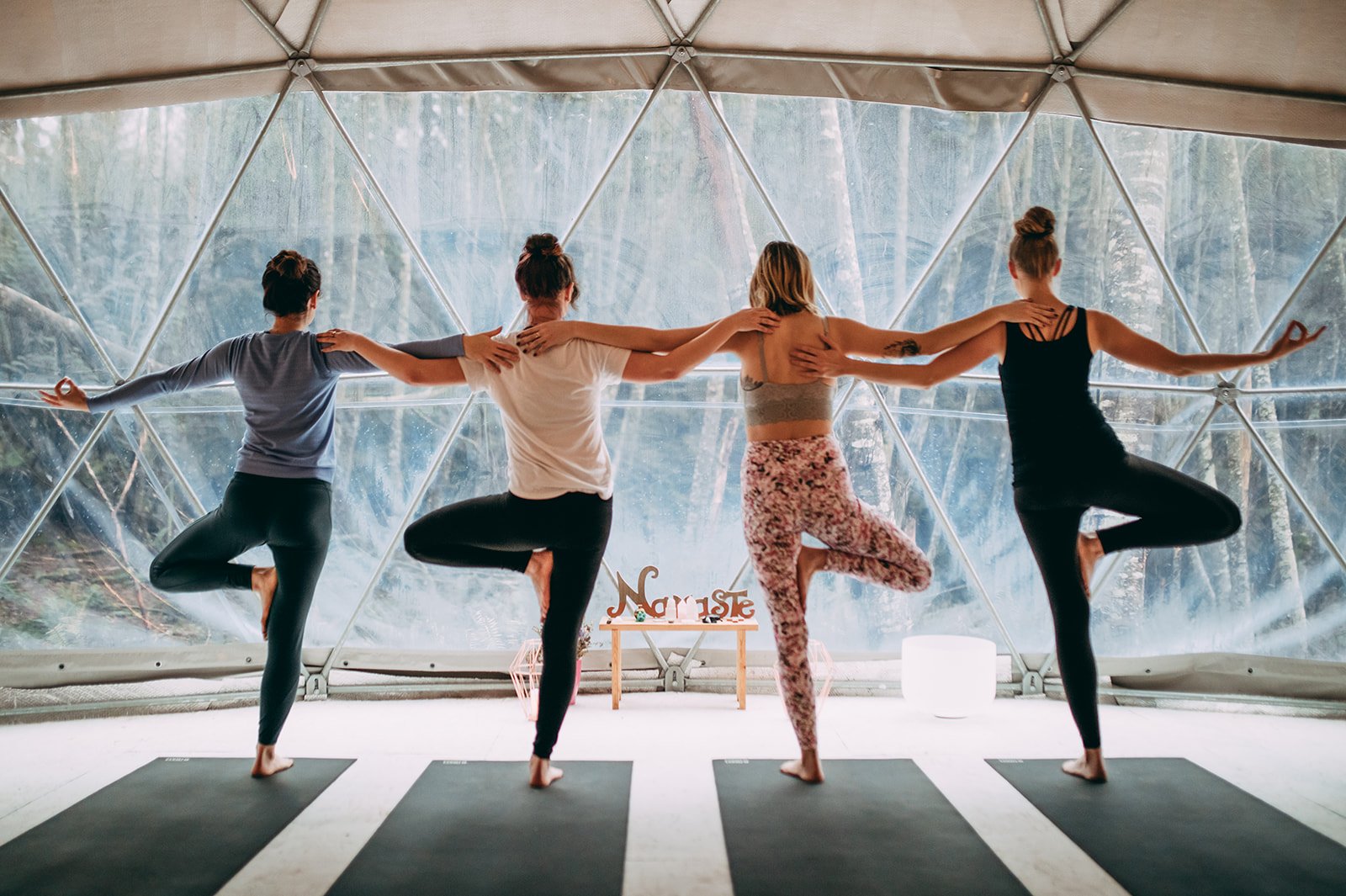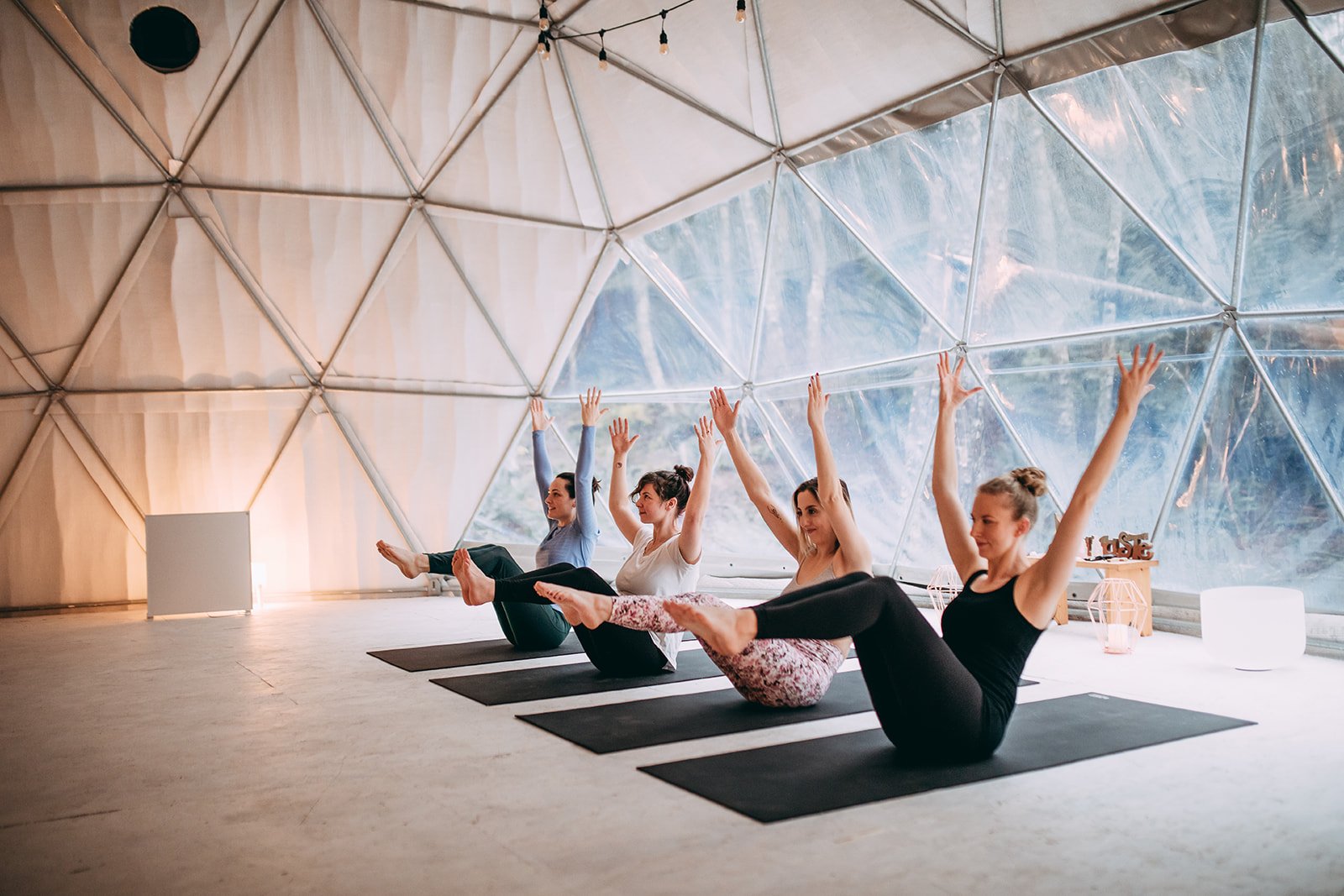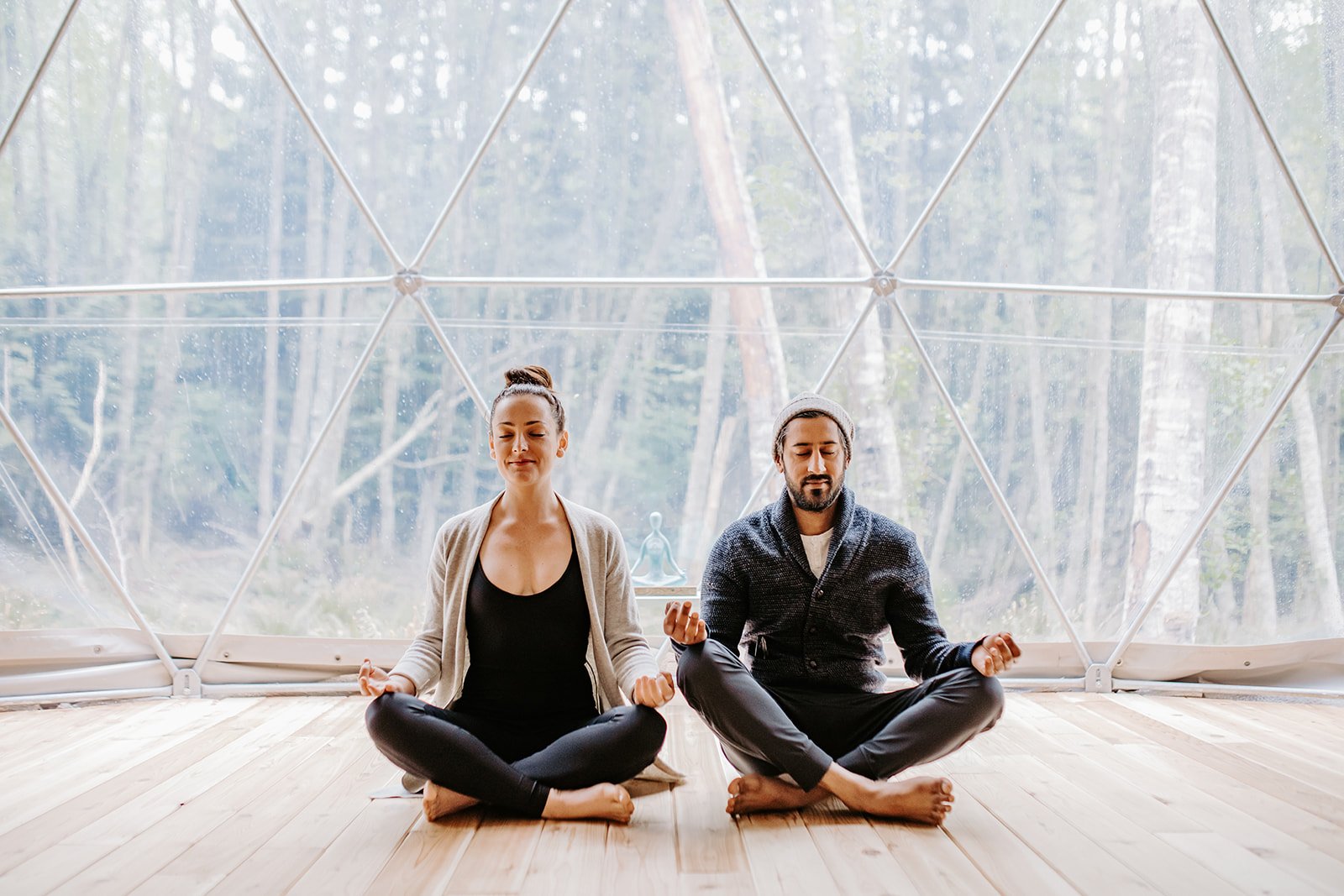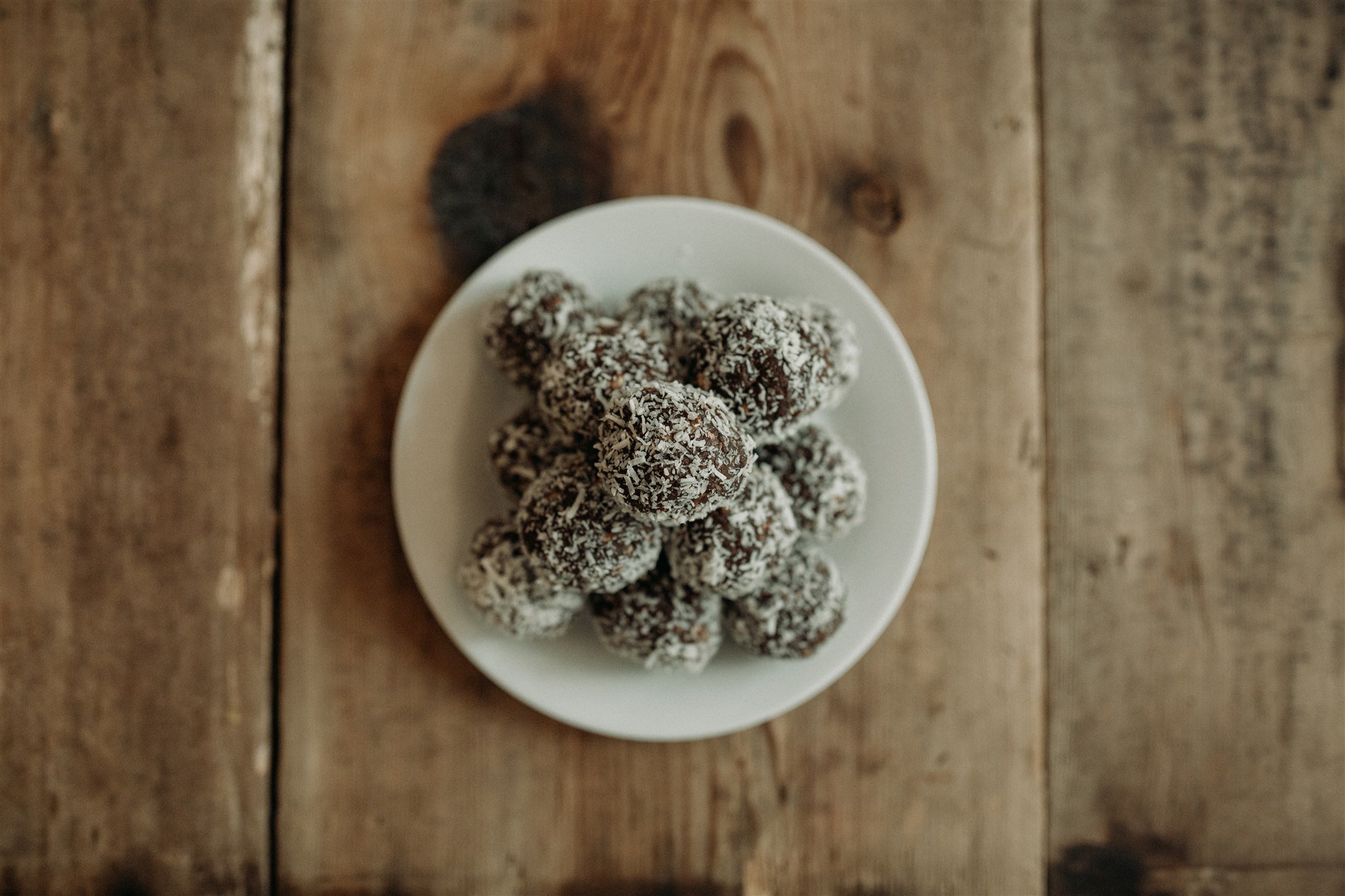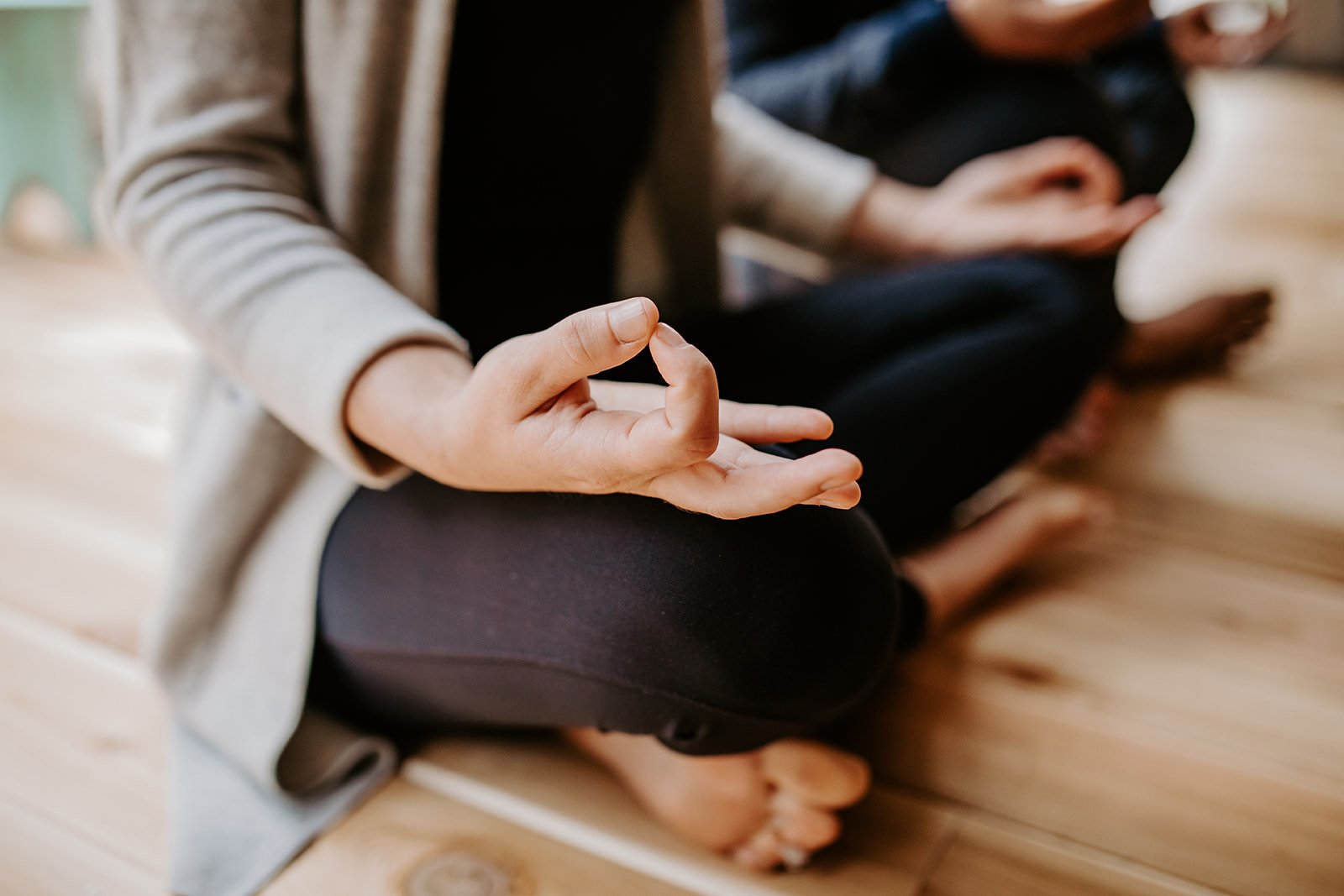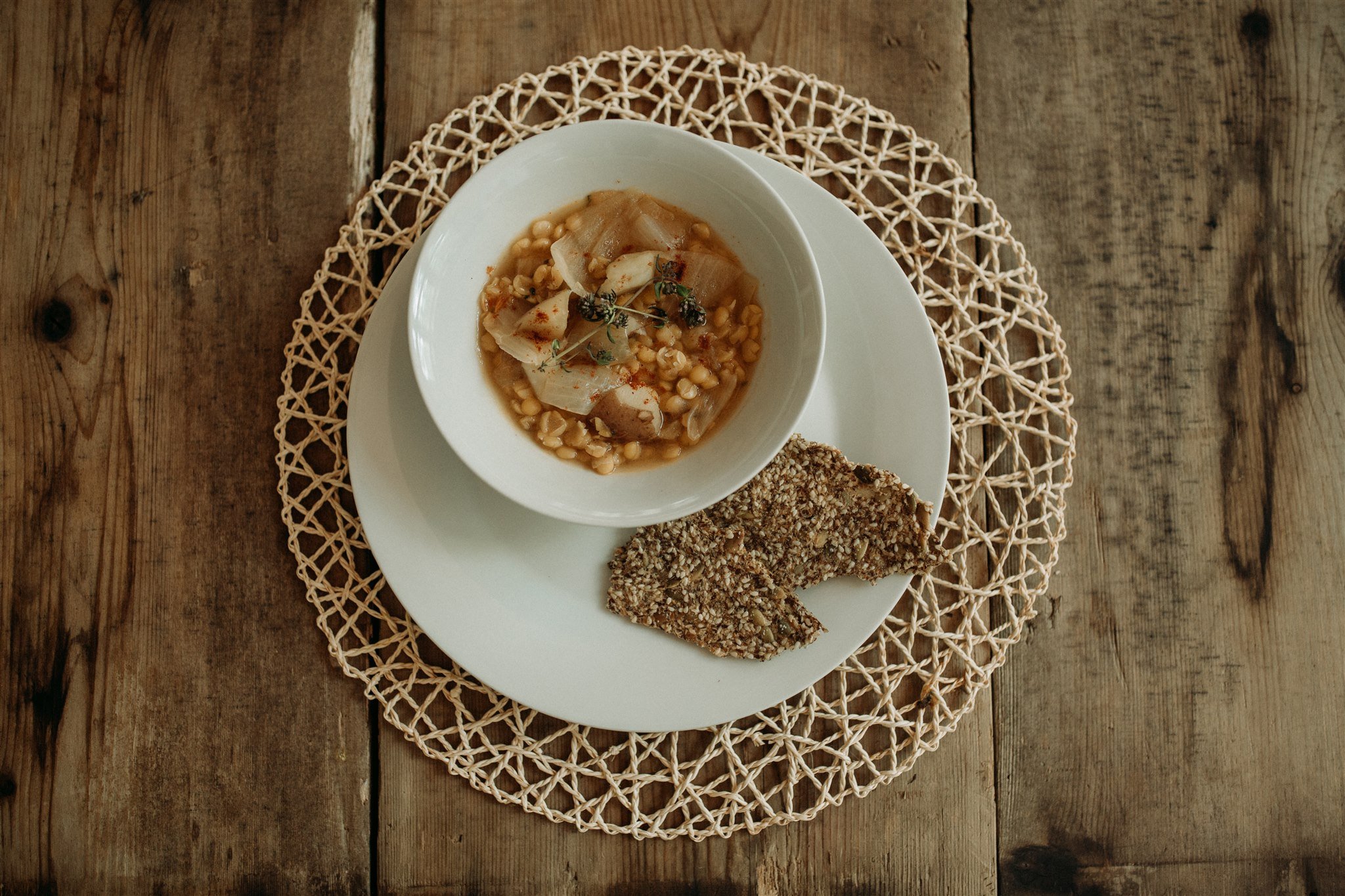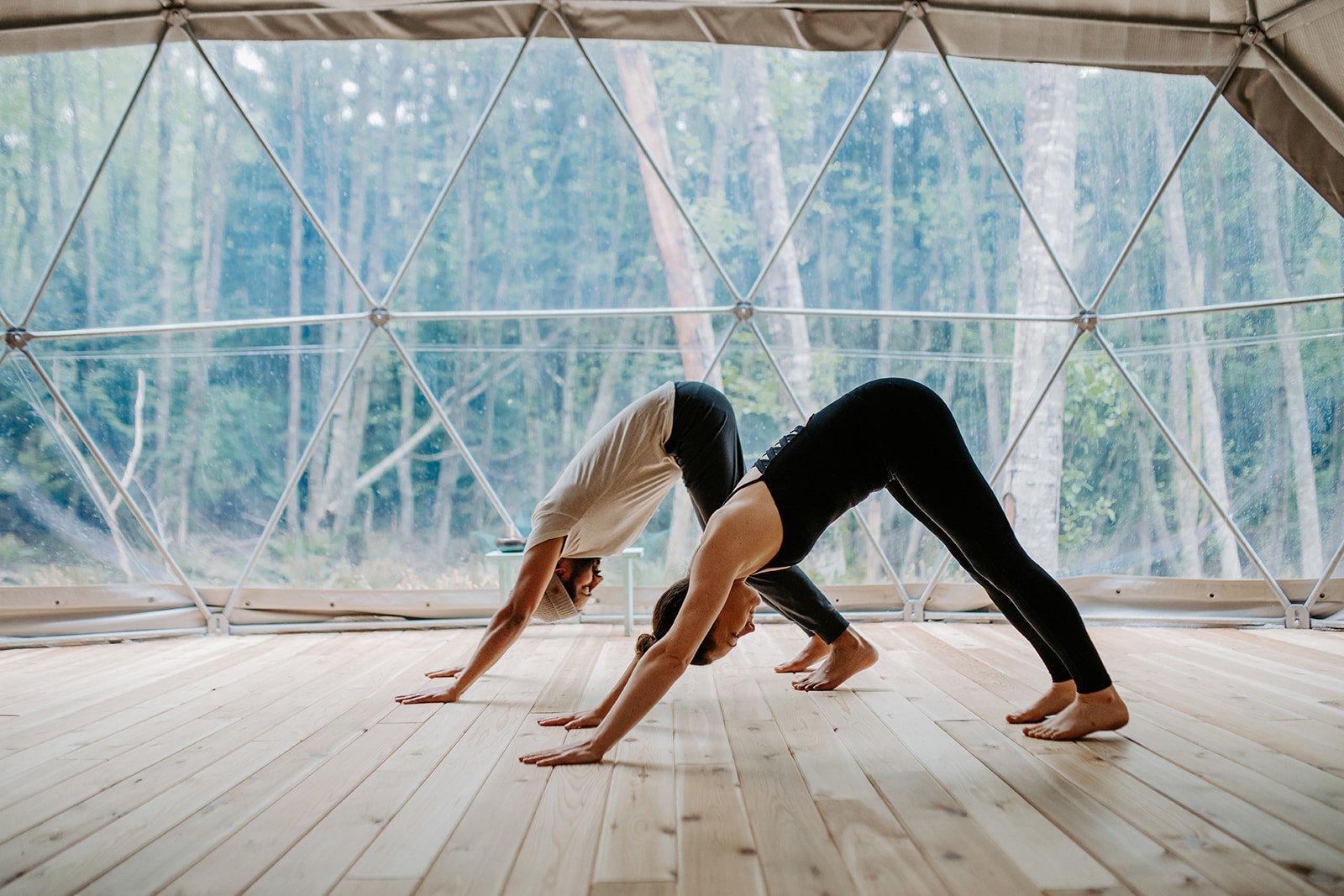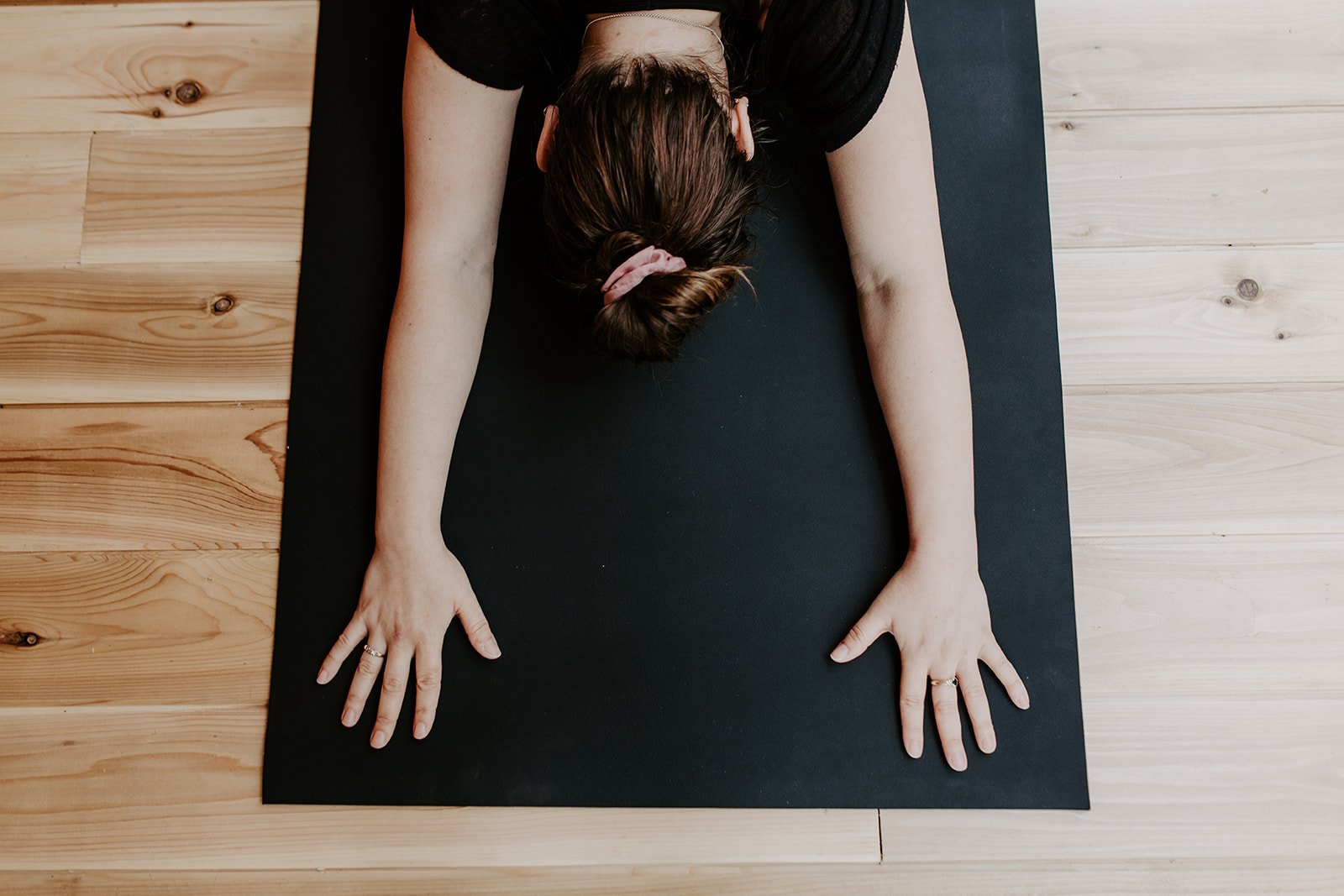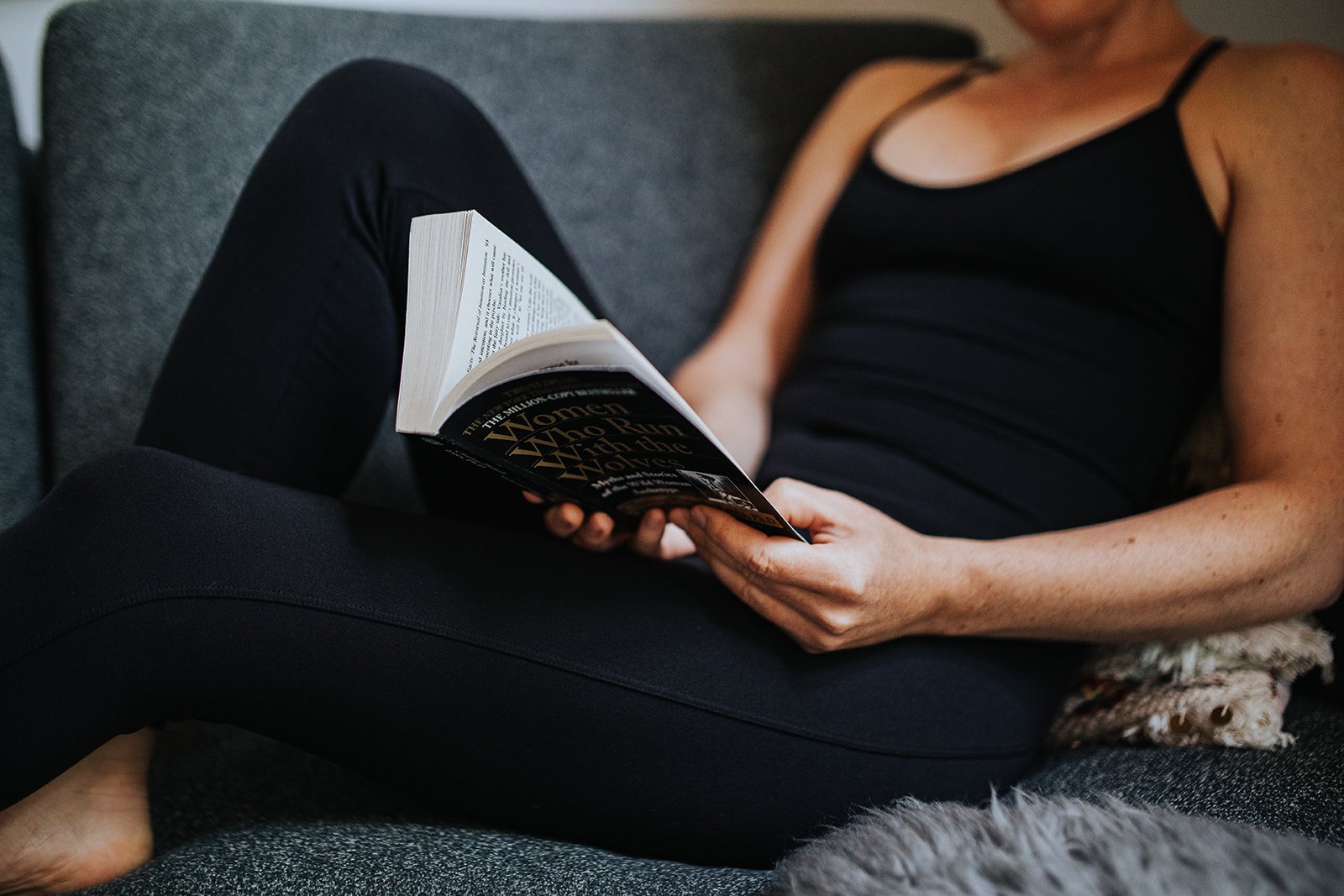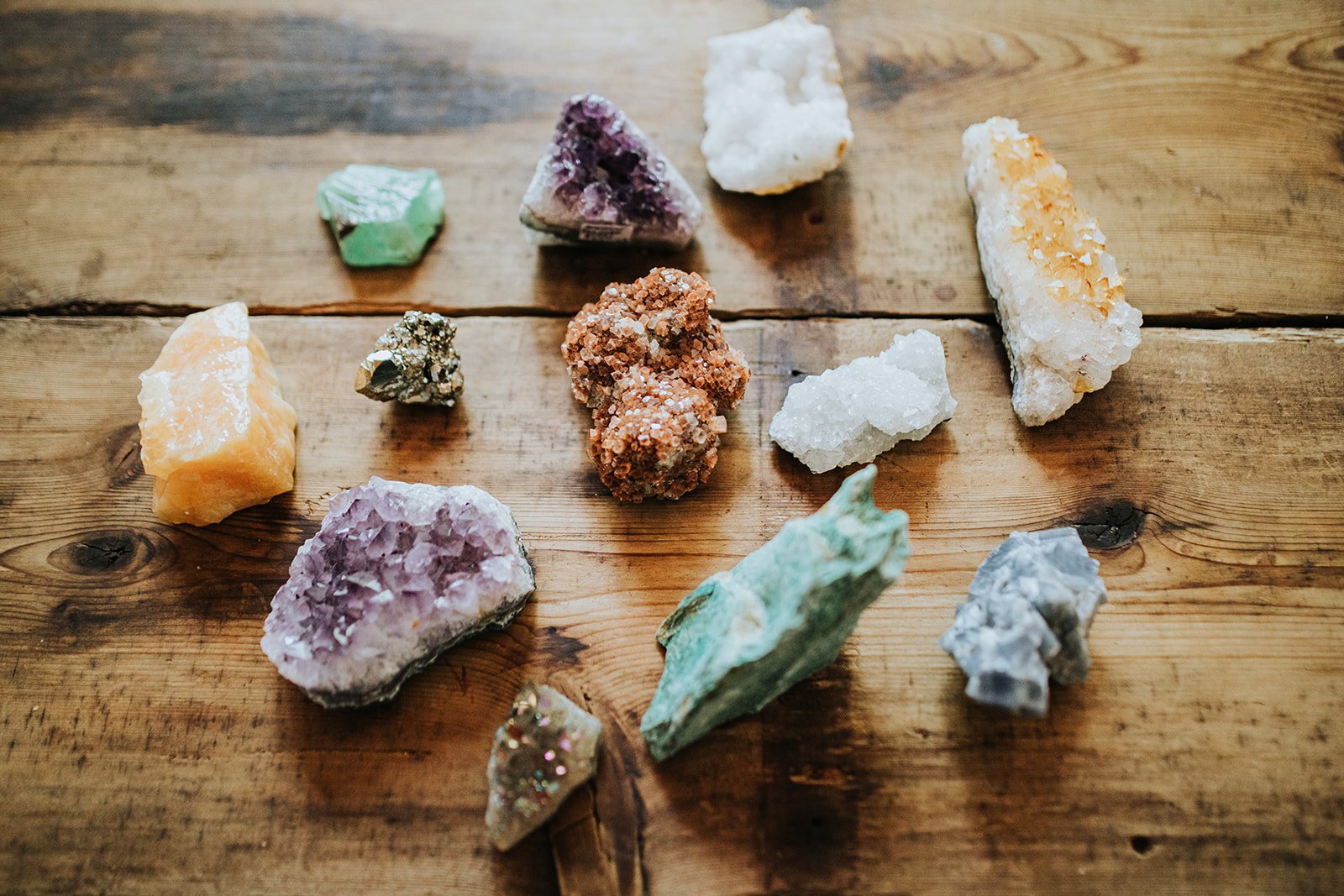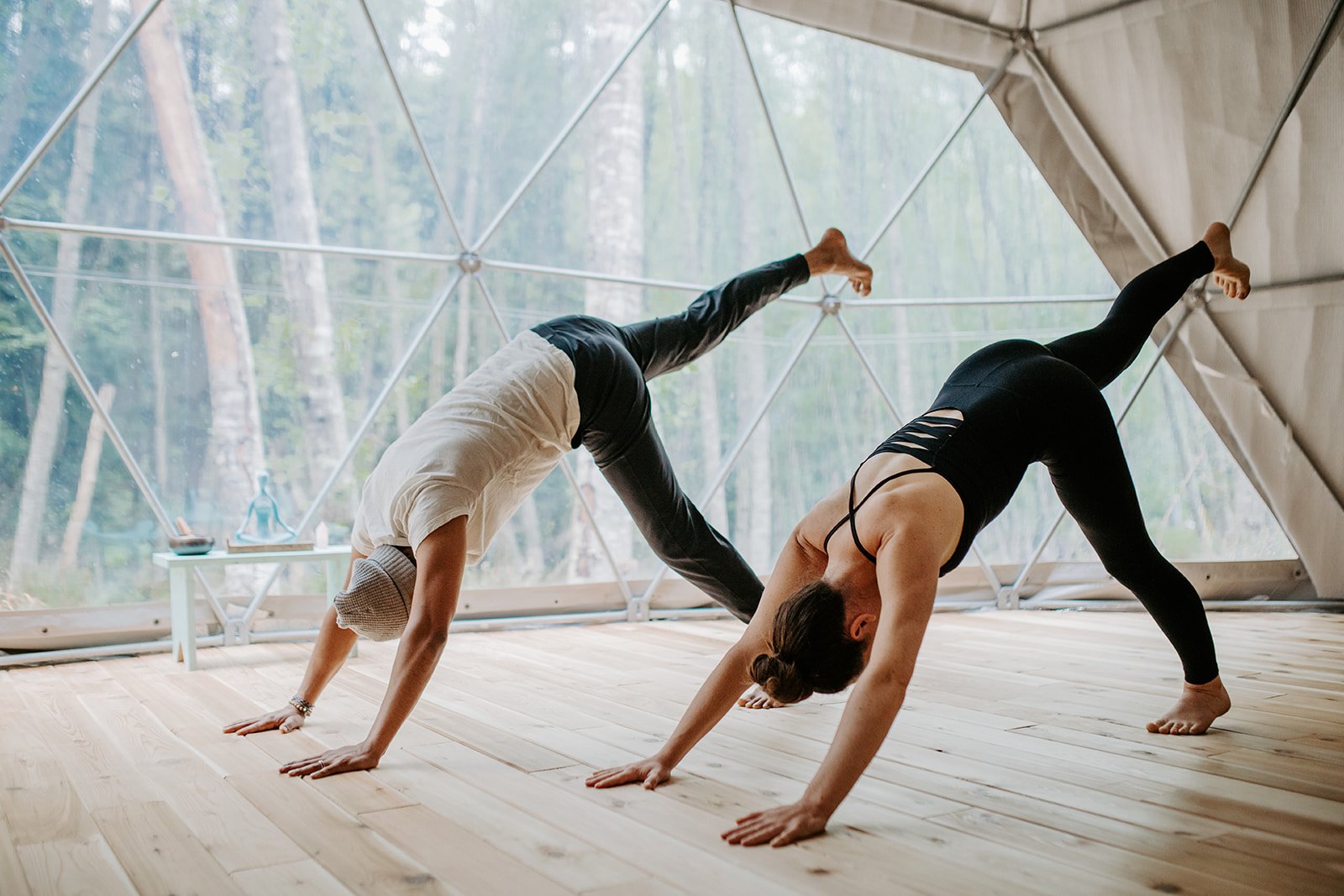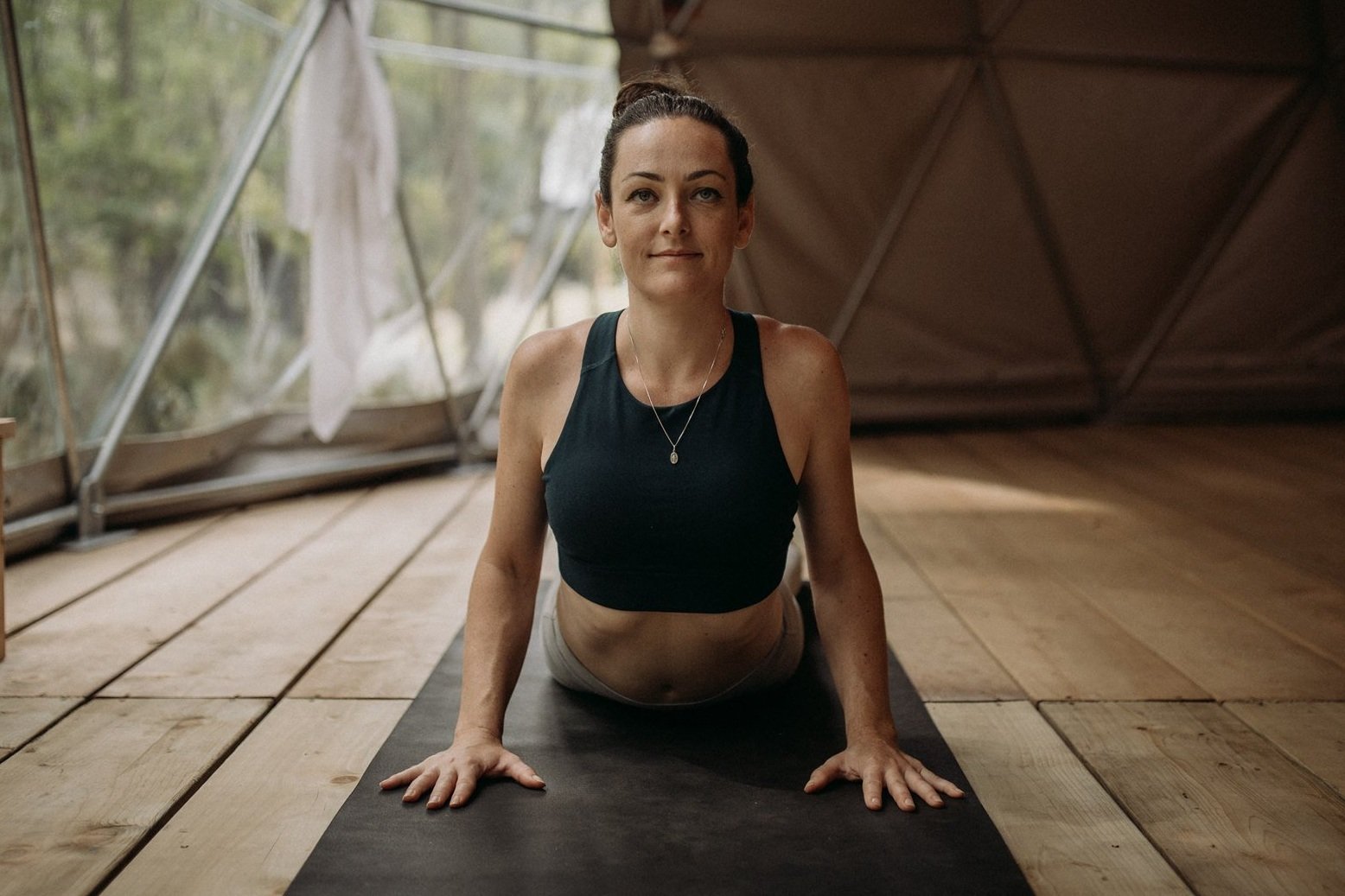As we surrender ourselves to the observance of Santosha, we discover that contentment is not a destination to be reached, much like how Saucha is also not an arrival point, but a way of being—a way of embracing the fullness of life with hearts wide open. This practice may not make us immune to undesirable situations in our lives, but it can sweeten our perspectives, inner stories, and how we respond to the insatiable demands of our need for gratification. May contentment be part of what anchors us to ourselves, to each other, and to the divine presence that dwells within us and among us. In many ways, this is both a personal and community practice, something that can be cultivated at home, and also further amplified (or activated) at a nature retreat here at Nectar Yoga on Bowen Island, BC. There is something profoundly powerful when you are witnessed by others, and when you witness others cultivate Santosha with intention.
What Is Sound Healing + How Does It Work
Guest Blog Post by Mia Cara Cosco.
Sound healing has received significant media attention in the last few years alone for its numerous benefits and even celebrity attention.
Sound healing is an ancient art, given the historical significance of instruments going back seemingly as old as the dawn of civilization. History depicts sound healing has been exercised in various forms over time, from chanting to ward off evil spirits to playing music for mental health-related illnesses. Music has been used since to boost morale in military troops, aid people in productivity and so many more situations + cultures around the world.
Health Benefits Of Sound Healing
A trained practitioner is typically trusted to lead a sound healing experience, as it’s not actually as easy as hitting bowls or twirling a chime. Different aspects of music improve physical and emotional health.
Sound healing can also happen by way of moving along to the music in small or large motions. If meditating is something seen as “common”, then this is an act of going beyond simply listening to the music because you are also working to empty your mind of thoughts and resolve any fidgeting (which can be easy to do). Sometimes, sound healing can even be through the act of playing an instrument yourself. From experience, this can be a deeply soothing and contemplative experience that puts you in touch with a flow state.
Sound healing has had some interesting niche findings in the research, such as boosting immune function by lowering stress levels and improving the health of premature babies. Research has also found these general benefits:
reducing stress
decreasing anxiety
improving memory
reducing blood pressure
lowering cholesterol
minimizing pain
decreasing risk of heart disease and stroke
Much of these findings also correlate with mindfulness meditation — much of sound healing puts you in a state of inner flow and intentional stillness. Once the habits of fidgeting and intrusive thoughts are put aside to immerse yourself in it, the healing or noticeable effects of meditation or sonic frequencies can be felt potentially quite deeply.
Overall, with health as a primary value, it seems as though we have evidence to shift our focus from the typical model of health to a perhaps more ancient one. Sound healing has rebranded in white-washed western culture, however, the benefits have only become more well-known to science. Music and sound can change our state almost in an instant and this can be incredibly powerful for healing our body and mind.
What Instruments Are Used?
Any and all instruments can be ultimately used to heal, depending on what resonates with you and what sound you prefer, thus there really is no right answer to this. With that said, there are certain instruments designed and typical for sound healing studios that are worth mentioning:
hand pan
pan flute
chimes
harmonium
tuning forks
singing bowls
tongue drum
gong
harp
It is common for music therapists to use well-known instruments, such as the guitar or piano, for performances as well. More culturally specific instruments, such as the sitar or zither, can also be found depending on where you are in the world.
Your preference in music or what sounds you like to hear often occurs on a subconscious level and may not be something you can rationalize. If you’re interested in finding a sound healing studio or a sound healer to experience the technique first-hand, make sure to ask these questions in the process:
Are there specific types of music you like to listen to?
Are there music genres you are uncomfortable with?
Would you prefer to be moving or meditating while sound healing is happening?
Are there instruments you are more interested in hearing?
Are there instruments you don’t like the sound of?
What Sounds Are Right For You?
Let’s get into the specifics of what sound frequencies can be healing—and for what. This is helpful to know about the Solfeggio frequencies, rediscovered by the physician and research Dr. Joseph Puleo in the 1970s:
432 Hz—the standard tuning for ancient musical instruments pre-20th century, deeply calming and soothing which is best for sleep
528 Hz—ability to heal and repair the body even after just 5 minutes due to its stress reduction power in the endocrine system and autonomic nervous system
396 Hz—helps remove subconscious fears, worries and anxiety by eliminating feelings of guilt and subconscious negative beliefs to help you feel uplifted
639 Hz—balances emotions, elevates mood and promotes communication with harmony and understanding into interpersonal relationships
741 Hz—problem-solving, bodily cleansing and self-expression to awaken intuition and promote simple living to live a healthy lifestyle and express creativity
852 Hz—replaces negative thoughts with positive ones and aids in awakening intuition and inner strength for living in harmony with your highest self
Notice How You Feel
There is no use trying to endure an uncomfortable experience when the purpose is to heal. With that said, brief moments of uneasiness are inevitable in any new experience as humans. An instinctual yes or no is essentially relying on our sympathetic and parasympathetic nervous system. These are slower, gradual insights and realizations that come from a steady mindfulness practice overall.
I am supremely grateful to the gracious team at Nectar Yoga for the opportunity to write about one of my favorite loves, sound healing.
Many thanks as well to the sources linked in this piece, rich in knowledge and wisdom on various healing modalities and practices.
If you took something away from this piece or learned anything, tell me below! What did you take away from this or have you experienced the benefits of sound healing first-hand? I would love to see your comment!
All Photos - Nectar Yoga Copyright
Forest Bathing | The Benefits + How To Practice
There’s a reason why the largest cities in the world have parks, trees, + pockets of nature woven throughout their busy streets. Studies have found that spending 10 to 20 minutes a day outdoors can lead to an increase in overall well-being and happiness — and decreased amounts of stress; meaning these bits of nature added to urban life are lending a positive impact on a people’s day to day life.
Aside from spending time in city parks, the more in-depth practice of forest bathing has been proven to have physical + mental health benefits across the board.
The term ‘Forest Bathing’ references a physiological + psychological practice that emerged in Japan in the 1980s. This practice, also known as ‘Shinrin-yoku’, was cultivated to help people achieve two goals; to relieve feelings of burnout while also inspiring residents to connect with, and protect the country’s green spaces. Forest Bathing is an open-ended practice in the sense that there is no right or wrong way to experience it. It can be as simple as standing in nature and noticing the smells, sounds + sights the area provides you.
The Benefits Of Forest Bathing Include:
lower blood pressure
reduced levels of cortisol (stress hormones)
strengthens immunity
relieves anxiety
improves concentration
improves short-term memory
energizes the body + mind
improves mood
strengthens sleep patterns
While the word “forest” is in the name of this practice, heading to a rural wooded area is not required. You can take a trip to a nearby park, your favorite local trail, the beach, or any natural setting close by. The focus is to move through this practice with intention and mindfulness; meaning being present and fully in the moment. If you can, turn off or silence your phone or other devices that may distract or interrupt your time.
Once you’ve arrived at your chosen spot, take some deep breaths and ground yourself. Let yourself notice all that your senses are taking in — whether it’s the scent of towering trees or the sounds of chirping birds.
Allow yourself to spend a few moments observing your surroundings. You might choose to do this practice in stillness, movement or a combination of both. Sit and watch how the trees sway in the wind or simply walk around. If you decide to walk, go at a leisurely pace and without a specific destination in mind. It is important to let your mind and senses explore + indulge.
Safety tip: Always pay attention to your surroundings, stay on marked trails, + wear appropriate clothing/footwear. Consider things like sun protection or any possible allergies you may have; be respectful of nature around you, and leave no trace other than footprints. When possible, bring a friend or let someone know where you’re going and for how long.
A good rule of thumb is to practice forest bathing for at least 20 minutes every day. If you don’t have that much time to spare, that’s absolutely fine. You can start with a shorter amount of time. The goal of forest bathing is to relax + detach — this practice shouldn’t feel like a chore. The aim is for this to be something you look forward to and enjoy.
No matter how much time you spend outdoors, remember to look for moments that bring you to awe. You can also tie your forest bathing practice to your journaling practice (we have a whole blog post about different journal practices for you HERE).
After each session of forest bathing, use your journal to note your experience or any thoughts you had while immersed in nature. This is a good way to keep track of how the practice is making you feel over time — and help you create an additional ritual that supports your overall heath.
Gratitude to our community near and far, both for taking the time to explore our blog and for walking the path to your best self - we hope this resonated and aids you in finding balance within.
Thanks and credit goes to the resources for this blog provided by the writers and healthcare professionals at Kaiser Permanente
Let us know in the comments where you like to spend time forest bathing or how you feel about it.
All Photos - Nectar Yoga Copyright
Finding Your Practice | How To Start + Continue On Your Yoga Journey
Whether you’re starting your yoga practice fresh, or coming back to it after some kind of hiatus, the benefits + gains from it are truly wonderful whilst versatile. However like most new endeavors, when we are in the beginning stages it’s easy to feel overwhelmed, unsure and unmotivated.
Which is why we' have compiled a (hopefully) helpful list of not only the benefits of cultivating your own personal yoga practice, but what lineages you might resonate with, what to look for in modern yoga studios as well as teachers.
Most importantly as you begin to practice yoga, know that this is much more than a form of exercise (that’s yoga Asana, we did a whole blog just about that HERE)
The movement practice of yoga can bring a wide array of physical and mental health benefits, as well as moral lessons that can be applied to day-to-day life “off the mat.”
In Sanskrit, the word ‘yoga’ translates to ‘to yoke’ or ‘union.’ The practice thus encourages us to unite our thoughts, feelings and actions to our present state, while moving forward on a personal path that will allow us to be the best version of ourselves, contribute to the greater good of our communities and society overall.
Some things to consider and reflect upon as you start your search for yoga classes:
How do you typically feel when you try new things and what helps motivate you to stick with it when you feel uncomfortable?
Do you prefer in person or online classes?
Do small or large class sizes feel more appealing?
If you’re choosing online, how often will you go to in person classes? (this is important to check in for proper alignment cues)
Health Benefits: Why Do You Want To Do Yoga
Our sympathetic nervous system controls our fight or slight response. And with daily stresses being the main trigger of this survival mechanism rooted deep in us, we may find ourselves uncontrollably releasing excess adrenaline, a hormone that increases your heart rate and breathing.
This fight-or-flight response helped our ancestors escape or make their way through dangerous situations, like a charging bear, however in the modern-day, the stressful situations we find ourselves in general are not the same life or death threats as our ancestors experienced, thus the adrenaline released is overly excessive. Yoga is excellent at activating the parasympathetic nervous system (which controls the rest + digest aspects of our body) and developing a relaxation response that counters chronic stress.
Other Health Benefits Of Yoga Include:
Improved sleep patterns
Improved strength, flexibility + balance
Increased energy
Less chronic pain
Lighter moods
Can help lower blood pressure
Many people start yoga as a path toward improved health, reduced stress and self-discovery. A sustained yoga practice can help you fulfill these goals.
If going to a modern yoga class is something new, you’ve moved to a new city/area or are coming back to the practice after a personal hiatus, ask yourself the following questions:
What Do You Want To Accomplish?
Your goals may include:
Improved flexibility + balance
Increased strength
Stress reduction
Gain more body awareness
Next, think about what type of class you might prefer. Are you more interested in a relaxing, slower class or an active and challenging one?
Before choosing, we recommend talking to your healthcare provider to make sure the movement practice of yoga is safe for you.
From there, start with a class deemed All-Levels, or even better, something specifically curated for beginners. Look for a beginner Hatha, Yin or Restorative class to attend. If you have some experience and want a class that incorporates more physical movement and strengthening, try Ashtanga or anything labeled ‘Vinyasa’ or ‘power yoga.’
All yoga studios should offer descriptions of their classes and be able to answer any questions you have beforehand. Whether you’re a beginner or an advanced yoga student, there is a class out there that meets your needs.
What Are The Staff + Instructors Like?
A yoga studio with friendly, experienced + helpful instructors will help to motivate you to keep coming back. During your first visit, the studio staff should:
Greet you with kindness
Inform you about the available equipment, such as mats + props, and where you can find it
Offer a tour of the facility
Review the rules of the studio and what to expect with each class
Do You Feel Comfortable During The Class?
Yoga classes should be accessible + inclusive. They should offer a welcoming, supportive environment free of judgment and competition. You should never experience pain or discomfort or feel forced into anything. Be sure attend and support classes that allows students to advance at a pace that’s comfortable and individualized.
As you experience different yoga classes, you’ll find that some classes align with your ideals more than others. Finding a class that focuses on the breath, promotes meeting yourself where your are and makes you feel safe is what matters most.
Find A Teacher Who Will:
Encourage you to stay within your limits. Most yoga injuries happen when you let ego take over and push yourself too hard
Focus on breathwork throughout the class. Breath is the foundation of yoga and is paramount for a healthy, sustainable + proper practice.
Help you modify the postures based on your abilities. This might include using props to help support you or a chair if you can’t lie on the floor, giving cues to safely get you in and out of poses, and offering modifications to poses to make the class accessible to all in attendance
Gratitude to our community near and far, both for taking the time to explore our blog and for walking the path to your best self - we hope this resonated and aids you in finding balance within.
Thanks and credit goes to the resources for this blog provided by the writers at Cleveland Clinic and Jade Yoga
Let us know in the comments below what motivates you to go to yoga class?
All Photos - Nectar Yoga Copyright
What Is Asana?
This limb has become equated to ‘the yoga practice’ in the modern western world, yet it is only one of many other limbs that make up the true yoga practice. In the yogic view, the body is a temple of spirit, the overall and complete care of which, is an important stage of our spiritual growth.
Through the practice of physical postures we develop the habit of discipline + the ability to concentrate, both of which are necessary for cultivating healthy routines in life.
Asana is outlined in Patanjali’s Yoga Sutras, a collection compiled around 400 C.E. This was the first text to codify the practices of yoga, and is considered to be the foundation of classical yoga philosophy.
Sutra 2.46 outlines the qualities required in order to practice asana: “Sthira Sukham Asanam”. In Sanskrit, Sthira translates to strong, steady or stable, whilst Sukha translates to: ease, comfortable, relaxed. From this, Asana is described as a balance between stability + ease.
The Yoga Sutras only refers to postures used for seated meditation, however this description of Asana is also relevant to standing postures and all modern forms of the practice. Regardless of the style of yoga, practitioners are generally encouraged to seek a position that is both steady and comfortable.
According to Patanjali, the primary focus of Asana is to move to, and maintain a long and upright spine in order for energy to flow freely during seated meditation. Although modern Asana alignment cues are not limited to seated postures, you may notice that teachers will still tend to focus on the direction and free flow of energy within the body during a class.
Different texts and teachers throughout history have outlined varying numbers of Asana. The classic texts of Hatha yoga as taught by Lord Shiva, account for 84 postures, specifically highlighting that the first four are necessary to achieve spiritual perfection.
These postures are:
Siddhasana (Accomplished Pose)
Padmasana (Lotus Pose)
Bhadrasana (Gracious Pose)
Simhasana (Lion Pose).
Other scriptures, such as Gheranda Samhita (which highlights a seven-fold yogic path,) suggest that there are as many as 8.4 million yoga postures, to reflect one for each living creature in the universe.
More recently, Sri Dharma Mittra compiled a list of 1,300 Asana.
Different Types Of Asana Yoga
Hatha
Beginning with the foundational yogic tradition, Hatha yoga consists of asanas ideal for the beginner student. Poses are typically gentle with a moderate amount of flow. The pace is slower than most forms of yoga and the practice accessible to people of all ages and levels of fitness. Hatha yoga is all about balancing the solar and lunar energies within each and every one of us.
Vinyasa
Vinyasa yoga is currently one of the most popular forms of yoga. It consists of linking the breath with the movements in a fluid sequence, which is especially helpful for beginners. It is can be suitable for all levels, depending upon the particular class. Most classes begin with the flowing movements of Sun Salutations, and then move on to integrate other Asanas.
Yin
Yin yoga is a type of restorative practice based on the traditional Daoist philosophy of the energies of yin and yang with the aim of the practice being to evoke the effects of yin energy, allowing the body to fall into its’ natural state of equilibrium + relaxation.
Yin yoga practice is accessible to yogis of all levels of physical fitness. During a Yin yoga class, each asana is held for a long period of time, typically three to five minutes or longer. The goal is to reduce muscular engagement and target connective tissues instead. This leads to an overall deeper stretch and increased relaxation.
Ashtanga
The Ashtanga yoga system was made popular by the beloved teacher, Pattabhi Jois. Although Pattabhi Jois has left this physical world, his legend lives on in the Ashtanga yoga system, which is one of the most physically challenging of them all. This is the type of yoga to go to if you want an intense workout, as well as a very regulated set of Asanas.
Despite the fact that the Ashtanga yoga sequences are always the same, they get harder and harder as you move through the levels, keeping the practice forever new and challenging. This style of yoga takes discipline, but the rewards are many.
Jivamukti
Jivamukti finds its origin in the Ashtanga style, but with other elements mixed in. This style —invented by partners, David Life + Sharon Gannon — is strict and structured similar to the style Ashtanga, but with the added practices of kirtan (chanting), meditation and spiritual teachings. It is both physically challenging and spiritually rich —perfect for the modern-day yogi seeking a great workout paired with soulful inspiration and rich teachings.
Viniyoga
Viniyoga is a style of yoga that finds its origins in the teachings of T. Krisnamacharya + his son, T.K.V. Desikachar. A Viniyoga class is often taught privately, with a sequence tailored to fit the needs of the student based on age, physical condition and current overall level of well-being. It focuses upon the movement of the spine as well as the movement of the breath.
Iyengar
Iyengar yoga was made popular by B.K.S. Iyengarnfrom Pune, India. This style is known for being heavily alignment-based, and incorporates the use of various yoga props, such as straps, blocks + blankets into the practice. High attention is given to the details of each posture, as the poses are held for longer periods of time than in Ashtanga or Vinyasa yoga classes.
Anusara
Anusara is a style that became well known by a modern day yoga teacher named John Friend. It revolves around the philosophy opening the heart, as well as the practices of Tantra. Similar in ways to Iyengar yoga, Anusara focuses on an alignment-based system, with an emphasis on therapeutic Asanas. It is often characterized by uplifting philosophy interwoven in the teachings and is a suitable style for any level of yogi.
Kundalini
This style of yoga Asana is a spiritually rigorous yoga practice with a focus pranaymama (breathwork), chanting and kriyas, which are repetitive and often fast-paced movements. The aim of Kundalini yoga is to unleash the energy which lies dormant at the base of the spine. Attention to breath control as well as the bandhas ( internal locks) are a huge aspect of this style of yoga. Kundalini yoga is a powerful practice and should be done with the guidance of an experienced teacher.
Sivananda
Sivananda yoga is a more traditional form of yoga that focuses on the following: a sequence of 12 specific Asanas, Pranayama, yoga philosophy, relaxation, meditation and a vegetarian diet. Although it is a disciplined style, it is still accessible to most levels.
Bikram
This style of yoga is also known as “hot yoga,” in the western-modern world. It is practiced in a room heated between 95 - 105 degrees Fahrenheit, which allows the muscles, ligaments and tendons to loosen up. This is one of the most vigorous forms of yoga and not an accessible practice for all-levels of yogis or certain body types.
Forrest
Created by Ana Forrest — this is another style of highly physical practice. Its primary intention of this practice is to promote deep physical and emotional healing, with an emphasis on deep abdominal breath work, to help stoke the fires within while cleansing the connection of mind and body.
Asana is best to be practiced on an empty stomach, and without using excessive force or pressure to move into a posture. To enhance the benefits of any physical yoga pose, it can be combined with pranayama practices, such as Ujjayi or Kapalbhati.
Regardless of the yoga style, Asana should always be practiced with mindful awareness, as a means of uniting the body, breath and mind. Specific Asana can be used therapeutically to help alleviate specific health problems or physical issues under proper guidance, teaching and body awareness.
Gratitude to our community near and far, both for taking the time to explore our blog and for walking the path to your best self - we hope this resonated and aids you in finding balance within.
Thanks and credit goes to the resources for this blog provided by the writers at Eckhart Yoga + Yogapedia
Let us know in the comments which style of Asana you prefer to practice!
All Photos - Nectar Yoga Copyright
Journaling Practices - The Benefits + Styles
When you were a teenager, at some point or another you likely kept a diary hidden about your room. Journaling in it was a place to safely share your struggles and fears without judgment, shame or criticism. Getting all of those thoughts and feelings out of your head and down on paper probably felt like a release and a relief.
However you may have fallen out of the routine of using a diary or journal once you reached adulthood.
But the concept and its benefits of it are still there for you.
Putting your thoughts and feelings onto paper allows you to better understand them and see them more clearly. Writing about situations or interactions, allow you a chance for deeper reflection. Journaling as an overall practice can help you gain control of your emotions while improving your mental health.
Try these tips to help you get started with journaling:
Try to journal routinely.
Set aside a few minutes every day to write, ideally in the mornings shortly after you wake up, or as part of your bedtime routine. However, if this seems like too much to start, choose a specific day of the week to journal. This will help you to write in your journal regularly.Keep it simple.
Keep a pen and paper handy at all times. Then when you want to write down your thoughts, you can. You can also keep a journal on your smartphone.Write or draw whatever feels intuitive.
Your journal doesn't need to follow any certain structure. It's your own private place to discuss and create whatever you want to express your feelings. Let the words and ideas flow freely. Don't worry about spelling mistakes or what other people might think.Use your journal as your own personal resource.
Your journal and your practice of writing in it are for you alone, meaning you don't have to share your journal with anyone. If you do want to share some of your thoughts with trusted friends and loved ones, you could show them parts of your journal.
Keeping a journal helps for a sense of order when your world may be feeling chaotic. You can get to know yourself better by revealing your deepest fears, thoughts, and feelings. Treat your writing time as a form of self-care; knowing that you're doing something good for your mind and body. Journaling is a time and tool that allows you to let go of things you no longer need to carry and reflect in a calm state. When you set aside time to journal, set your space intentionally, as you would with a meditation or yoga practice; wear something comfortable and warm, perhaps light a candle, and/or have a favorite beverage to sip on as you write.
Benefits Of Journaling
Before exploring the various forms of journaling, it may be helpful (and encouraging) to know the multiple benefits that come from its’ consistent practice.
Improves Communication + Writing Skills
Like everything, writing only improves with practice. When you journal every day (regardless of the style,) you are simultaneously practicing the art of writing. If you use a journal to also express your thoughts and ideas, you are also improving your overall communication skills.
Tracks Growth + Progress
If you make journaling a regular practice, you can revisit previous entries and see how much progress or growth you’ve made.
Boosts Confidence
Another benefit of revisiting your former journal entries is being able to see your progress, which generally leads to a boost in confidence (and serotonin). Be proud of yourself for the challenges you faced and how you overcame them.
Aids In Achieving Goals
When you use your journal to write down your intentions, you can track your goals as well as plan how you want to accomplish them. Journaling is a valuable tool that allows you to stay accountable while serving as a reminder of what you need to do to accomplish them.
Reduces Stress + Anxiety
Often times negative thoughts or emotions can run on a loop in our heads. This can be stressful when you are already dealing with a challenging situation — it generally tends to make your situation feel worse. But if you stop and put your emotions down on paper, it can help you release negative thoughts from your mind. As you write, you may even come up with a solution you hadn’t thought of before.
Strengthens Your Memory
Research has proven that writing your thoughts down can reduce intrusive thoughts about negative events and also improve working memory. What may seem like the simple act of writing something down, reiterates to your nervous system that this is something you specifically want to remember. This is why taking notes is such an effective practice when learning something new.
Find Inspiration
Many famous artists, poets and writers, drew and wrote the roots of what would later turn into the historical art pieces we admire to this day, in their journals. Like them, you can also use your journaling time to brainstorm or let your imagination run wild. The inspiration that may pop up while you’re writing or sketching might even surprise you.
Different Styles Of Journaling
Stream Of Consciousness Journaling
Arguably one of the most popular forms of journaling and most freeing. Ignore spelling, grammar, punctuation and everything else, give yourself the permission to allow your thoughts to flow from your mind directly to the page. None of it needs to “make sense,” this style holds space for getting things out and capturing your thoughts in action.
It is common to draw a blank when starting out, in which case the ‘Morning Pages’ exercise outlined in The Artist’s Way by Julia Cameron can be helpful to get started. The exercise outlines that you should try to free-write three pages every morning, challenging yourself not to stop writing until it’s done (even if that means writing “I don’t know what to write” over and over again).
Gratitude Journaling
Practicing gratitude has been proven to increase one’s state of happiness over time. Taking the time to notice the things in your life that you are truly grateful for, can impact your thought process and reactions to people and situations you encounter in your everyday life. Creating a journaling practice while simultaneously cultivating more gratitude in your life will allow for organic space to be created in which you can reflect and grow into the best version of yourself. Gratitude journaling is best practiced at the start or end of your day.
Bullet Journaling
This form of journaling is a great method for anyone who particularly appreciates having things concise and organized, as well as aesthetically pleasing. It combines several journaling goals into a very organized system. It can be used as a daily diary, a calendar and task manager, a place to reflect and process things—just about anything you’d do in a regular journal, you can do with bullet journaling.
What sets bullet journaling apart from other styles is that you don’t typically start with a blank page, but instead use a journal with a dot grid pattern as the base to create beautiful, organized layouts. We encourage you to also use colorful pens + pencils, patterned washi tape, and stickers to make their journaling pages visually appealing and allow your artistic creativity to flow simultaneously as you write.
Dream Journaling
Form a deeper connection with your subconscious mind through this form of journaling. Keep your journal next to your bed and jot down the details of your dreams as soon as you rise in the morning. If you wake up in the middle of the night from a particularly intense dream, write whatever memorable details down about it before going back to sleep, as you may likely forget by morning. Documenting your dreams allows you to work through unprocessed issues in your waking life and come to terms with them. Psychologists believe that there’s a scientific link between our minds and our behaviour; in which dream journaling can give valuable insight into our unique thought processes and patterns we create in our sleep.
Sketch Journaling
If you are someone who is naturally drawn to creating visual art, this style of journaling may come most organically, or at the very least be the foundation to build your journaling practise upon. Rather than writing, this form of journaling encourages your to express your feelings, thoughts + ideas through illustrations, sketches or even doodling. Drawing how you feel, or a scenario you’ve encountered allows for the same release as writing, as well as presenting the same prospect for reflection, through seeing your thoughts on a page in front of you.
Day’s Events Journaling
This practice of journaling is best done in the evening after your day is done. You may choose to write in bullet point style or complete sentences as you re-examine and note the events and emotions that day entailed for you. However you chose to record it, noting your day in your journal is especially beneficial in getting into a daily routine of journaling, as well as allowing your future self a greater opportunity for clearer memories to review and reflect upon at any point later on.
To-Do List Journaling
Instead of keeping an ongoing mental tally of to-do items, write them down in your journal. You can cross things off as you complete them, which not only gives you a great sense of accomplishment but allows you to track everything that you still want to get done and overall be more organized. Similar to bullet journaling, you may choose to write everything in shorthand rather than with proper grammar/punctuation, as well as get more creative in terms of the layout and look of your List Journaling. The style of journaling is favored among those who would label themselves as “Type A”.
There are many styles of journaling you can explore, the above is what we have found to be useful for cultivating a routine of journaling. Just like any other self-care practice, you know what is best for yourself and we encourage you to try different styles of journaling to find exactly what resonates with you most.
Regardless of which type of journaling style(s) you decide to explore, remember that there is no right or wrong approach - the act of taking the time to get in touch with your mind, body, + spirit is what is truly important.
Gratitude to our community near and far, both for taking the time to explore our blog and for walking the path to your best self - we hope this resonated and aids you in finding balance within.
Thanks and credit goes to the resources provided by the University of Rochester Medical Centre
All Photos - Nectar Yoga Copyright
An Overview Of The Raja Yoga System
In Sanskrit, Raja translates to ‘king" or ‘royal," referring to the status of Raja yoga as the "royal path"’ or the predominant form of yoga. At Nectar Yoga we follow these teachings both on and off the yoga mat, curating our practices as well as the way we conduct ourselves, to demonstrate how Raja yoga can be integrated into modern daily life and the benefits it brings.
Traditionally, Raja yoga refers to the objective of yoga as well as the method of attaining it. Through this, it is also considered to be the state of peace and contentment that comes from a sustained yoga + meditation practice. It also encompasses teachings from all the different paths, and it is from Raja yoga that Hatha yoga and modern Asana practice has developed.
Considering that Raja yoga involves all three dimensions of human existence (physical, mental + spiritual), it empowers practitioners to find harmony on each of these levels.
Although Raja yoga generally emphasizes meditation to being the path to self-realization, the term has come to refer to a much more vast range of practices.
In the 19th century Raja Yoga text, Swami Vivekananda equated Raja yoga with the Yoga Sutras of Patanjali; since then Raja yoga has been used or referred interchangeably with Ashtanga yoga, or the ‘eightfold path’ to spiritual liberation.
According to Raja yoga, the largest obstacle to self-realization is a busy mind, in which uncontrolled thinking, ego, desire, attachment + separate sense of self all contribute towards suffering.
Working through each limb in Patanjali’s eight limbs of yoga brings the practitioner close to an enlightened state of consciousness known as Samadhi, in which it is possible to experience the truest version of yourself.
The eightfold path, also referred to as the eight limbs of Raja yoga are:
Yamas - Five social observances.
Niyamas - Five moral observances.
Asana - Yoga postures/poses.
Pranayama - Breath exercises to control + manage Prana (vital life force energy).
Pratyahara - Withdrawal of the senses.
Dharana - Concentration.
Dhyana - Meditation.
Samadhi - Enlightenment/bliss.
Yamas
The self-awareness gained by practicing the five Yamas can aide in transforming negative energy to a cultivation of peace. This is an overall practice of being more kind, accepting, and forgiving with both yourself and others.
The 5 Yamas are:
Ahimsa (non-violence)
The Sanskrit word “Himsa” translates to “harming, injuring, killing, or doing violence.” Ahimsa, the first of the Yamas is the practice of non-harming or non-violence both to yourself and others. This is the way of maintaining balance + harmony in your relationships in the world and with your truest self. As our journey unfolds, it leads to awareness of the tranquil yet enduring core that is our true nature; the desire to prevent harm is a natural expression of that awareness.
We begin to realize that the inner self in others is identical to our own inner self, and we wish no harm to come to any being. This includes the way we talk to and about ourselves, and others, the way we spend our time and energy, and with whom; and how we conduct ourselves out in the world, both when being “watched” and when alone.Satya (truthfulness)
Simply beyond the practice of “not lying,” practicing Satya is living in a way that aligns with your highest truth. It revolves around about being honest with yourself, with others, and abstaining from judgment — ensuring that you are consistent in speaking + acting with mindfulness and intention, rather than saying whatever is on your mind.Asteya (non-stealing)
This goes beyond the obvious of non-stealing, more than just not taking physical object that don’t belong to you. We can factor in hoarding items we don’t need, that instead can be shared with our community. As well as being aware of if we are utilizing more resources than necessary, such as letting the water run while you brush your teeth, leaving the lights on when you leave the house, etc.
But we can go deeper still – considering the act of stealing time. Time is something that, although set in a standard, reflects differently for every person. Managing our own time with grace, and showing up on time for someone else or a commitment is part of practicing Asteya.Brahmacharya (chastity)
The most talked about interpretation of Brahmacharya is celibacy. However there is a broader interpretation of this Yama; the prevention of the dissipation of one’s energy through the misuse of the senses. When you practice Brahmacharya, you are not letting the senses rule your behavior; rather practicing a personal energy-conservation program.
Anything that causes turbulence in the mind and stirs the emotions might be seen as a violation of brahmacharya: overstimulating foods, loud music, violent movies, and yes, inappropriate sexual behavior. Brahmacharya asks you to consider how you spend your energy.Aparigraha (non-possessiveness)
”Graha” translated from Sanskrit means “to grasp or to seize” and “Pari” to “things”; thus this Yama guides us in cultivating a balanced relationship with all things that we each call ‘mine.’
When we become possessive of anything, we are in turn possessed - however when we appreciate our possessions without becoming emotionally dependent on them, then they neither hold power over us nor lead to false expectations.
Niyamas
When put into practice the five Niyamas can be constructive tools for cultivating happiness and self-confidence; and when walking your path mindfully, the opportunities to practice them will present themselves every day.
Saucha (purity)
Saucha is not only the foundation for physical health, it is also the doorway to deeper and more tranquil states of meditation. Saucha encourages the practice of making mindful + wise choices surrounding your intake of food, emotions, thoughts and energy.
Keeping your thoughts uncluttered allows you be free of afflictive emotions; keeping your body + environment in order, also lends to creating a sense of calm. A mind trained by meditation has more complexity and orderliness. Physical orderliness can also positively affect the mind.Santosha (contentment)
This Niyama asks you to be aware that whatever you have in the present moment is enough. Once you can consistently do this, happiness will find an enduring place in your life. Santosha is a practice that cannot be found, rather it will find you once you have created the space for it.
On the yoga mat this can look like acknowledging your tendency to strive to do a ‘perfect pose’ yet meeting yourself where you are, using props or making modifications without feelings of shame or disappointment, rather gratitude for all your body does for you.Tapas (self-discipline)
The word Tapas is derived from the root Sanskrit verb ‘tap’ which means ‘to burn’, and evokes a sense of ‘fiery discipline’ or ‘passion’. In this sense,
when we perform our actions with full determination and effort, they are performed with Tapas.
Tapas can mean cultivating a sense of courage, self-discipline + passion in order to burn away ‘impurities’ physically, mentally and emotionally, thus paving the way to our true greatness.Svadhyaya (self-study)
The Sanskrit translation of “Sva” means ‘self,’ or ‘ own’ with “Adhyaya” translating to ‘lesson,’ or ‘reading,’ and while it can imply the practice of studying scriptures, it is also a practice of studying the Self.
When we listen to our ego, we often do or think things that do not align with our true beliefs or intuition and find ourselves reveling in fears and doubts; essentially the causing our own ‘Chitta Vrittis, (‘fluctuations of the mind). Bringing our awareness to ourselves and the way we go about our daily life allows us to become more aware of the things we do that harm us, and also that which serve us and bring us closer to that process of yoking with the our truest self.Ishvara Pranidhana (devotion or surrender)
Isvara Pranidhana is made up of two words; Isvara, which translates from Sanskrit roughly to ‘Supreme Being’, ‘Brahman’, ‘Ultimate Reality’ or ‘True Self,’ and Pranidhana, which means ‘fixing’. In most translations of this Niyama, we’re advised to ‘surrender’ to this Supreme Being or higher self, which in essence means cultivating a potent + trusting relationship with the universe, thus making each action an offering to something bigger than us. This Niyama encourages us to observe our thoughts and desires that distract us during moments of concentration, and from there redirect attention in the center of your being. At such times you may be able to transcend the limitations of your attachments and sense the presence of inner stillness.
Asana
This limb is has become equated to ‘the yoga practice’ in the modern western world, yet it is only one of many other limbs that make up the true yoga practice. postures practiced in yoga, comprise the third of the 8 limbs of yoga. In the yogic view, the body is a temple of spirit, the care of which is an important stage of our spiritual growth. Through the practice of physical postures we develop the habit of discipline + the ability to concentrate, both of which are necessary for cultivating healthy routines in life.
Pranayama
The Sanskrit word Prana translates to ‘energy’ or ‘life source’. It is often depicted as a description to the very essence that of each one of us and the energy in the universe around us. Prana is also synonymous with ‘the breath,’ and by noticing + controlling the way we breathe, we can affect the mind in a powerful way.
Generally our life force flows unconsciously out through our nervous system + senses so that we are cognitive of the world around us. Through various practices of Pranayama that same life force is directed inward toward the higher centres of spiritual awareness throughout the spine + brain, so that we may perceive the brightest path within us.
By practicing Pranayama we free the ourselves from the distractions of life by a direct means — controlling the flow of bodily energy that would otherwise keep our consciousness outward. We allow our restless thoughts to find a path of peace and become open to knowing our truest self.
Pratyahara
Pratya translates in English to ‘withdraw’, ‘draw in or back’; and the Sanskrit word “Ahara” refers to what we ‘take in,’ - such as sights, sounds + smells our senses constantly take in. The practice of drawing inward may include bringing our awareness to our breath, our actions, our emotion, and our responses through day to day life.
Withdrawal as a term, may initially bring to mind the idea that we are practicing a form of turning our senses ‘off’ through concentration + intention, which is why this aspect of practice is often misunderstood.
Rather than dampening our senses through awareness of our state of being, the practice of Pratyahara changes our state of mind so that we become so in tune with what it is we are focusing on, that the world around us no longer distracts us and we are able to meditate or bring intentional awareness within, without becoming easily distracted.
Dharana
Dharana means ‘a focused concentration’. With Dha translating to ‘holding or maintaining’, and Ana meaning ‘other’ or ‘something else’.
Linked particularly close to the previous limb, Pratyahara with the understanding that in order to focus on something, the senses must withdraw so that all attention is put on that point of concentration, and in order to draw our senses in, we must focus and concentrate intently. The exercise of Tratak (candle gazing in an otherwise dark room), visualisation, and focusing on the breath are all practices of Dharana.
Dhyana
Dhyana is the Sanskrit word that translates to “meditation.” It is derived from the root words, Dhi, meaning “receptacle” or “the mind”; and Yana, meaning “moving” or “going.”
The seventh limb builds upon the practices of Asana, Pranayama, Pratyahara + Dharana. When practiced together with Dharana and the eighth limb of Samadhi, the yogi does not see it as a meditation practice; as they are so fully immersed that they can no longer separate the self from the practice.
Samadhi
Many of us know the eighth limb Samadhi as reaching ‘bliss’ or ‘enlightenment’, and in a sense it’s an accurate relation when practices of having reorganised our relationships with both the outside world and our own inner world, are being exercised.
Breaking the term into its’ individual Sanskrit words, we see that this final limb is made up of two words; Sama translates to ‘same’ or ‘equal’, and Dhi means ‘to see’. There is a reason it’s referred to as a ‘realization’ or ‘coming to,’ as Samadhi is not about leaving the world around you, it’s about truly noticing the very life that lies in front of you.
One of the most important things to remember is that Samadhi is not a permanent state once achieved… rather a consistent sum of practices working towards it. Mindfully shedding our attachments, aversion, influences from ego, desires + habits, particularly in the modern western world is a life-long practice
Once the mind is pure and we truly do experience a state of Samadhi we can keep hold of, we attain Moksha, (also known as Mukti,) meaning a permanent state of being liberated + free.
These eight limbs offer a systematic approach to calming the mind + seeking the path of freedom. Raja yoga is ultimately a means of transcending identification with the body-mind-intellect complex in order to truly recognize and know the nature of your truest self.
Gratitude to our community near and far, both for taking the time to explore our blog and for walking the path to your best self - we hope this resonated and aids you in finding balance within.
Thanks and credit goes to the many talented writers + resources provided by Yoga International, Yoga Journal + Eckhart Yoga
All Photos - Nectar Yoga Copyright
The Three Doshas Defined By Ayurveda
There are three doshas described in Ayurveda: Vata, Kapha + Pitta
Knowing the details of the three doshas and what your Ayurvedic body type is can be so helpful in syncing your inner rhythms each season.
Originating more than 3000 years ago in India, Ayurveda, a natural system of medicine, is known as the sister science to Yoga. The term Ayurveda is derived from the Sanskrit words Ayur (meaning: life) + Veda (meaning: science or knowledge);
which translates to Knowledge of Life.
Ayurveda encourages lifestyle interventions and natural therapies to find balance between the body, mind, spirit, as well as the environment.
The dosha(s) within us become more predominant when we fall into the corresponding season in the year:
Pitta = Late Spring + Summer
Vata = Fall + Early Winter
Kapha = Late Winter + Early Spring
“Understanding the qualities of each of these seasons can help you reduce any adverse effects. Remember that your predominant dosha increases during the season it governs, so take care to choose foods and activities that will pacify and not aggravate it.” - Kathryn Templeton via Yoga International
Pitta Dosha | Ruled By The Elements Of Fire + Water
Seasonal Aspects
Pitta = Late Spring + Summer
Pitta season is composed of themes surrounding all that is oily, hot, light, spreading, liquid. This time of year can show up in the body as agitation, high digestive fire and skin irritations.
Our internal fire is burning just as brightly as the flora + fauna surrounding us, bursting into full growth. Naturally these are the seasons that usher us into our most energetic tendencies. The seeds we’ve consciously planted in the early spring are sprouting with life and to avoid feeling burnt out, it’s important to pause and allow moments to rest and cool down as the fiery energy pushes us to keep going.
Personality Attributes
The common traits of Pitta-dominant types are hot, sharp or penetrating, light, liquid, spreading, a little oily, and sour. This dosha is responsible for mentally digesting life experiences and biologically digesting food. Pitta is responsible for chemical and metabolic transformations.
“Mental [processing], sound judgment, and discernment are functions of balanced Pitta… Regarding transformation, Pitta governs the ability of the body to combust, or digest, the materials needed to bring warmth and color to the body. The body’s ability to maintain warmth and absorb sunlight as well as our ability to mentally digest our thoughts and emotions are governed by Pitta dosha.” - Kathryn Templeton
Yoga Asana Postures For Pitta Season
*(modify to suit your practice/body)
Adho mukha svanasana; downward facing dog
Janu sirsasana; seated head to knee pose
Pavanamuktasana; knee to chest pose
Janu Sirsasana; head to knee pose
Malasana; squat pose
Stay Nourished With
Watermelon
Coconut
Fig
Kale
Figs
Kale
Cilantro
Cabbage
Papaya
Raisins
Strawberries
Flax seeds
Almonds
Foods that help balance Pitta are sweet, bitter, and astringent in taste. Ayurveda recommends sweet, sour, salty, pungent, bitter, and astringent tastes for healthy digestion. Find a full list in detail HERE
Vata Dosha | Ruled By The Elements Of Air + Ether
Seasonal Aspects
Vata = Fall + Early Winter
Mirroring the traits of late Fall to Winter, Vata season is dry, cold, windy, rough, light and erratic. Excess Vata can lead to imbalance, which can look like dry skin, constipation, insomnia or general lack of focus.
During Vata season, make sure that you are getting quality sleep; specifically to fend off any restlessness in the mind or body. This is a time that will naturally support you to seek a clear rhythm and routine to stay on track, and leave time for self care like meditation, self-massage or quality cuddle time if your have a significant other or a pet.
Personality Attributes
Generally quick learners, spiritually perceptive and are happiest when in contact with nature and the outdoors. They have a heightened sense of touch and a fine appreciation for beauty. You might recognize them as having their head in the clouds and speaking very enthusiastically + rapidly.
Vata dominant individuals can be prone to feeling wired and stressed, and thrive when they have early, consistent bedtimes. They are creative, individuals who are also usually active, alert and restless, always planning a new task or goal.
Yoga Asana Postures For Vata Season
*(modify to suit your practice/body)
Adho mukha svanasana; downward facing dog
Janu sirsasana; seated head to knee pose
Supta matsyendrasana; supine spinal twist
Setu bandha; bridge pose
Vata energy can feel flighty and enthusiastic, to stay balanced it is a good idea to do slower yoga practices to balance it out.
Stay Nourished With
Dates
Sweet potato
Red lentils
Watercress
Avocado
Pistachios
Zucchini
Mustard greens
Cucumber
Walnuts
Sunflower seeds
Choosing foods which have the opposite effect such as heavy, moist, smooth, sticky, slow, warm, stable, salty, sour + sweet helps to maintain balance or bring excess Vata back into equilibrium. Find a full list in detail HERE
Kapha Dosha | Ruled By The Elements Of Earth + Water
Seasonal Aspects
Kapha = Late Winter + Early Spring
While the weather and temperature may be cold and muddy, plants and animals are coming to life as winter moves towards spring. Looking to nature for direction on where to go with your own decisions always offers potent lessons. Mimicking the flora and fauna as seedlings are nurtured and ready to grow is a sound way to stay balanced during Kapha season, whether this is your predominant dosha or not. If you’re not already involved in an active lifestyle, this is a great time for you to change some habits and incorporate more movement into your routines; otherwise, the cold and wetness in your environment may lead you towards increased sedentary ways.
Wearing bright, warm colors during this time of year and diffusing scents such as eucalyptus, sage, and rosemary can offer a boost to your day. You can also balance your Kapha dosha with a daily dry massage known as a Garshana.
Kapha season is the time to go deeper into any sort of exercise program with specific attention placed on movement. When left untended Kapha tends towards stagnation and heaviness if it is not properly invigorated.
Personality Attributes
Kapha-dominant individuals are naturally compassionate, patient + calm. In the physical body, they have strong cognitive function and their joints are typically well-lubricated.
These people are prone to exhibiting physical and mental characteristics that carry the attributes of moist, cold, heavy, dull, soft, sticky, and static.
The key to balancing Kapha is stimulation.
Yoga Asana Postures For Kapha Season
*(modify to suit your practice/body)
Vajrasana; thunderbolt pose
Marjaryasana/Bitilasana; cat + cow pose
Surya Namaskar B; sun salutations
Virbhadrasana 2 (warrior 2)
Trikonasana (triangle pose)
Vrksasana (tree pose)
Stay Nourished With
Cloves
Cinnamon
Juniper
Okra
Black beans
Pumpkin seeds
Berries
Wild rice
Spinach
Peppers
Ayurveda teaches that Kaphas should eat foods with pungent, bitter, and astringent tastes. Foods with sweet, sour, and salty tastes should be minimalized as well as raw food. Find a full list in detail HERE
Gratitude to our community near and far, both for taking the time to explore our blog and for walking the path to your best self - we hope this resonated and aids you in finding balance within.
Extra thanks to Bayan Botanicals + Kathryn Templeton for the extra knowledge and resources surrounding the subjects above.
All Photos - Nectar Yoga Copyright



